|
|
Post by codystarbuck on Mar 22, 2020 14:26:13 GMT -5
|
|
|
|
Post by brutalis on Mar 23, 2020 7:39:10 GMT -5
Did I wander into the Non-Comic book comic book movies thread? Final Countdown truly deserves a place there for certain! One of my fave B movies ever! Saw it on the big screen when it came out and was absolutely enthralled with it. Even managed to convince my dad into going along with me to see it for my 2nd viewing. He was impressed enough to actually go and see it a 2nd time himself (he was in the bowels of a destroyer during WWII seeing the war through the portholes) as he liked that it was a more "real" science fiction type of movie than the likes of science fiction that he saw on television.
|
|
|
|
Post by codystarbuck on Mar 23, 2020 11:26:42 GMT -5
Did I wander into the Non-Comic book comic book movies thread? Final Countdown truly deserves a place there for certain! One of my fave B movies ever! Saw it on the big screen when it came out and was absolutely enthralled with it. Even managed to convince my dad into going along with me to see it for my 2nd viewing. He was impressed enough to actually go and see it a 2nd time himself (he was in the bowels of a destroyer during WWII seeing the war through the portholes) as he liked that it was a more "real" science fiction type of movie than the likes of science fiction that he saw on television. Yeah, I loved the fact that they don't try to figure out the time travel. It's just a mechanism to put the Nimitz in 1941 and they just let the story progress logically. I mean, what American officer, with enough firepower to destroy the entire Japanese Navy isn't going to try to stop the attack on Pearl Harbor? The Navy cooperated heavily with the film, which is part f the reason why Kauffman could get it done, since it helped keep the budget down. For the Navy, it was good PR in a bad era. We are still a few years away from Top Gun. I have the dvd, which included interviews with the pilots, who spoke glowingly of most of the cast, except Katherine Ross, though they mostly said she was stand-offish. Given my experience with pilots, it was probably for good reason. |
|
|
|
Post by codystarbuck on Mar 25, 2020 19:00:42 GMT -5
All-Star Squadron #16 Creative Team: Creative Team: Roy Thomas-writer, Adrian Gonzales-pencils, Rick Hoberg-inks, John Costanza-letters, Carl Gafford-colors, Len Wein-editor Da Ordster is taking off an issue. Synopsis: The All-Stars, replaced in time and world, enter the JSA mansion and enter the meeting room to find... 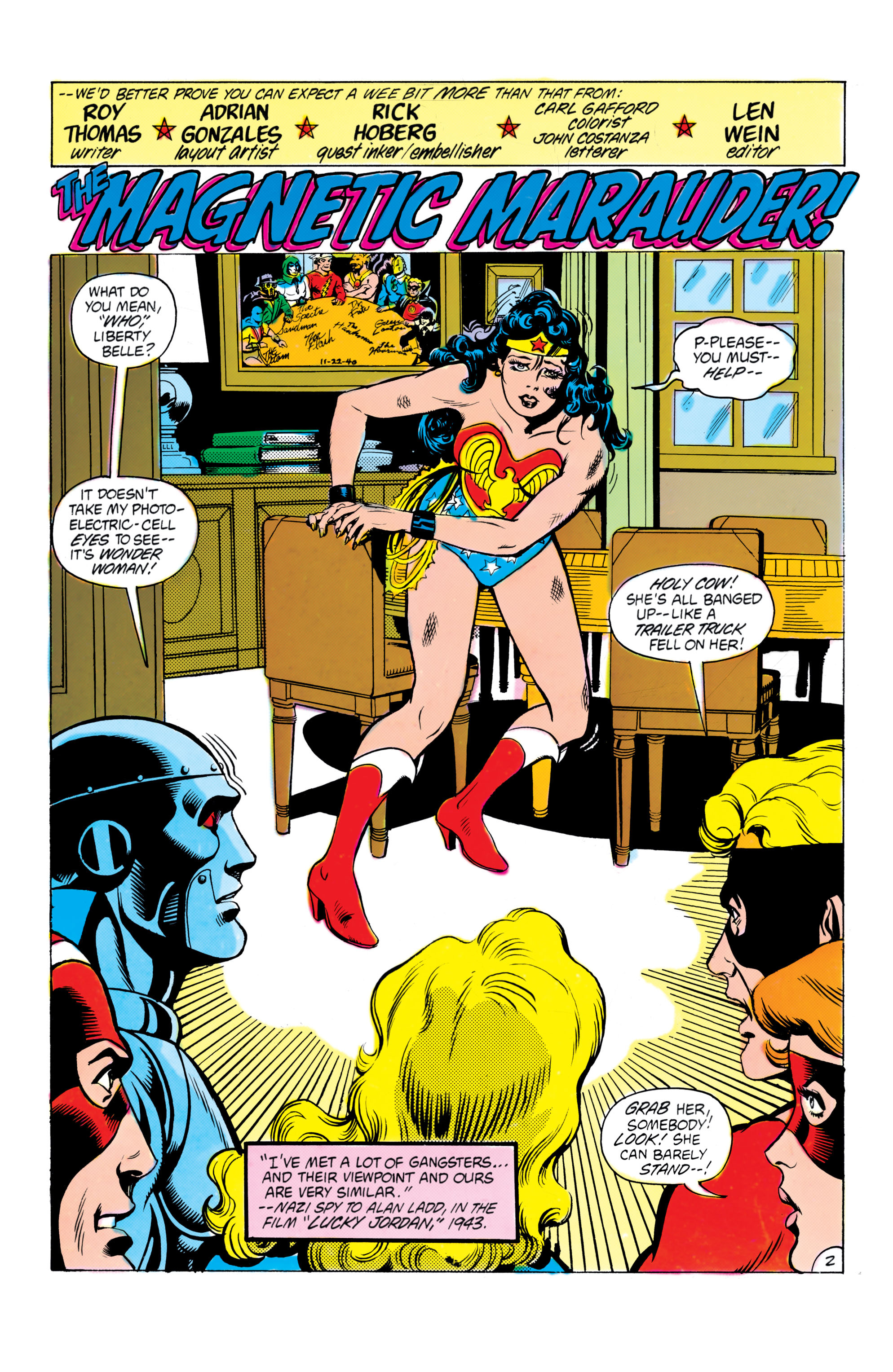 Well, at least it isn't Per Degaton or the JLA. Wondy is looking a bit worse for wear and collapses, muttering about Steve. She is revived ad mentions Nuclear, the magnetic guy the All-Stars encounter. When they mention it (and recap the fight) she flips out and starts busting heads on her way out of the building. The All-Stars subdue her when Steel puts himself in front of her and the red, white and blue calm her down. She then relates what happens, as Diana Prince is in Norfolk, meeting Capt. Steve Trevor, who is about to depart...  Diana's seams are crooked! The ship departs to head for the Pacific, via the Panama Canal and the Holiday Girls watch from the shore. The ship is attacked by Nuclear and pulled to shore. Diana switches to Wonder Woman, hops in her invisible plane and uses her lasso to pull the ship away. Steve gets tossed overboard and is rescued by Wondy, then he gets pulled up by Nuclear, as does Wondy, whose bracelets get clamped together, rendering her helpless. She then gets beat against a mountain like a piece of laundry...  Nuclear takes Steve and disappears on a submarine. Wondy headed for the JSA mansion to get help. The group goes to find Nuclear, deciding to investigate the area near where he escaped on the sub. They find a lone mansion on a cliff and set down to check it out. It is owned by Percy Playboy (formerly Plazchek), whose sister says something about a lab. While they are inside, Robotman is searching outside and finds a cave, with the submarine...  He also finds a bunch of generators and a bound Steve Trevor. He starts to free him, when Nuclear shows up and gets all magnety. He gets pulled into generators and Steve gets dumped in the drink, again. The All-Stars hear the commotion inside and rush down to the lab to check it out. The metal ones get tossed around, Wondy's bracelets get clamped again and Liberty Belle dumps any metal and gets a shot into Nuclear's gut. However, Nuclear has ripped off Robotman's arm (again) and is smacking people with it, including Belle. Percy's sister is a moron and can't figure out Nuclear is her brother. he claims to have killed Percy and tears up the floor to reveal a firepit (doesn't every villain have one?) and is going to dump them in. Firebrand play Bre'r Rabbit and goes first and turns the fire on Nuclear and melts some of the metal, freeing the others. They start smashing things and Steve sneaks up on Nuclear and shoots him in the leg. he falls into the pit and Percy's sister whines about saving him because only he knows what happened to Percy. Wondy's lasso comes up empty. Thoughts: This is a bit of a weird story; mainly because it is an attempt to emulate the style of the 1940s Wonder Woman comics. The reason for that is that this story is based on an unpublished one that featured Nuclear, who made his debut in Wonder Woman #43, in 1950. However, that story was titled "The Return of Nuclear." The previous story had been shelved and was destroyed in 1961. Roy created an original tale, in the style of Marston, to present the prequel to the published story, with no real knowledge of the plot. Later, a bit of artwork turned up, which was reprinted in Alter Ego #5 and #23, and then the last two panels in the All-Star Companion, Vol 3. As you would expect, Wonder Woman ends up in some magnetic bondage. The art is done in a pseudo H G Peters look, with Hoberg providing the finished look, as he was noted for his ability to ape Golden Age art styles. As such, it looks rather crude in places, though the All-Stars look a bit more modern. The name Percy Playboy is from the published story, but Roy found it too corny and gave them a real family name, Plazchek, based on a Chicago comic collector who Roy met in 1964. Adrian and Rick pretty much fail with the military hardware as the ship is supposed to be a destroyer and looks nothing like one (missing the guns, in some panels). There is a minor subplot, which I skipped, of Carter Hall soloing in an Army plane, before calling Shiera to tell her he earned his wings. The tail section looks like a P-40 but the front isn't even close. Regardless, a pilot would first solo in a trainer, before flying a warplane. Historical Notes: Not much to really cover. Hawkman should be flying a trainer, which at that time would have been the T-6 Texan... 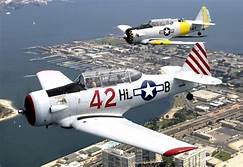 The plane was first test flown in 1935 and entered service in the Army Air Corps (prior name of the US Army Air Force) as a trainer. It was developed by North American and used to train prospective pilots, as it was a two-seater, with instructor controls and student ones. In 1937, Mitsubishi purchased two models for experimentation and possible license, but developed their own plane. ironically, the T-6 would be used by Hollywood to double as the A6M Zero, in such films as Tora! Tora! Tora!, Midway (the good one) and the tv series Baa Baa Blacksheep. A WW2 era destroyer should have looked like this...   That's the USS Stevens (DD-479), upon which artist Sam Glanzman served, and wrote about in his USS Stevens stories, and A Sailor's Story memoir. One other note, when Nuclear attacks the destroyer, we see sailors holding Thompson submachine guns (without buttstocks). The US Navy didn't really use the M1 Thompson (though Gonzales/Hoberg make it look more like the M1928 version, with the compensator and cooling fins), though the Marines did. The Navy generally carried the M-1 Garand Rifle or the Springfield 1903, the Browning Automatic Rifle (BAR), the M1911 Colt automatic, and 12 gauge shotguns. The Navy rarely engaged in combat via firearms, though all warships had an arms locker. They would use the Browning M2 .50 cal for anti-aircraft and shipboard defense, but mostly relied on their offensive weaponry: the 5 inch gun, with a range of about 13-15 miles. These were used for ship-to-ship combat, as well as naval gunfire support for amphibious landing. destroyers were also armed with 40mm anti-aircraft guns, torpedoes and depth charges. The purpose of a destroyer was to provide escort for capital ships (battleships, cruisers and aircraft carriers), provide anti-aircraft and anti-submarine screens, and provide support for amphibious operations. Destroyers were some of the most versatile warships and the workhorse of the Navy. One panel depicts an African-American sailor, in his whites and a t-shirt, wearing his "dixie cup" and carrying a Thompson. The US navy, like the US Army, was segregated during WW2. African-Americans were relegated to the Steward and Mess Attendant ratings, where they were relegated to the roles of servants. In World War I, they had also served as firemen (who lit the boilers that produced steam) and coal passers. The exception to this were members of special Construction battalion (Seabee) units, who primarily worked as stevedores (cargo handlers). However, all sailors had battle stations and many took part in defense of the ship. One of the heroes of Pearl Harbor was Cook 3rd Class Doris (Dorrie) Miller, who maned a .50 cal machine gun, on the USS West Virginia, earning the Navy Cross (probably should have been awarded the Medal of Honor). The Destroyer Escort USS Mason (DE-529) and sub chaser USS PC-1264 were the only vessels to be manned by an African-American crews, in response to a 1941 letter from the NAACP. Both were used for convoy duty. PC-1264 was notable for making a ship visit at West Point, where the enlisted sailors were given a tour of the grounds. However, the city of Miami Beach refused to allow the sailors to use a pier and nearby beach for swim qualifications. Civilian guards at the Subchaser base were noted for taking excessive time to examine African-American ID cards, vs white sailors. Sailors then heard rumblings of threats to go down and shoot up the "N***** ship." They armed themselves and waited near the gates. The nervous civilian guards asked what was going on and were informed, but no incident occurred. Following that, the number of racial incidents significantly decreased. The Coast Guard had similar restrictions and author Alex Haley (Roots) served as a Mess Attendant, until after the war and desegregation of the military (under Executive Order 9981, issued by Pres. Truman) in 1948. The story has Steve Trevor and Diana Prince embarked on a destroyer, traveling to the Pacific, via the Panama Canal. It was rare for a ship to transfer from the East to West Coast; however, there were more shipyards on the East Coast and many warships were laid down in them, then transferred to the Pacific Fleet (such as the USS Stevens, which was laid down in the Brooklyn Naval Shipyard). The Panama Canal Zone was heavily patrolled by the US Navy and was targeted by both the Germans and Japanese, via submarines. Roy says we are still in January 1942. Since Churchill has departed for England and arrived back home, we can assume that in is the latter half of the month. At this point, the US military is largely adjusting to a wartime footing. US forces are still holding out in the Philippines; but, the situation is worsening. Wake and Guam surrendered in December 1941. The US has yet to mount an offensive operation. the end of the month would see the first US troops arrive in Europe, in Belfast, on January 26. On January 23, the oiler USS Neches was torpedoed and sunk 120 NM west of Pearl harbor, by a Japanese sub, demonstrating that the naval base was still vulnerable. Around the same time, the Japanese begin the New Guinea Campaign, by attacking the island of Rabaul. Eventually, Rabaul will become the main Japanese base in the area, with extensive airfields and naval facilities, miles of tunnels and was a virtual fortress that stood until the Japanese surrender, after the bombing of Nagasaki. After 67 issues, Roy still hadn't reached 1943. We can only imagine how long it would have taken to get to Nagasaki. This is one of the problems of serialized fiction, as time tends to stand still. by contrast, the Belgian comics series Buck Danny, which begins with Pearl Harbor (with the first stories published in 1947) had reached the end of the war by 1952, after 6 albums (first serialized in Spirou) I've always had in mind a maxi-series that would cover the WW2 DC history, through the war. The main idea would be to relate the events of the war, from 1939 to 1945, with the DC war comics characters alone (plus Blackhawk, though modified to something a bit more historically accurate) No superheroes would be featured and no non-existent wonder weapons. Blackhawk would be an RAF formation of Allied pilots, from occupied countries, flying the Mosquito on special missions (as it was frequently used) Blackhawk himself would be the witness to the opening stages, before we'd move on to Mademoiselle Marie, for the fall of France and the Resistance. Sgt Rock would follow the US involvement from the Operation Torch Landings in North Africa, Sicily, to D-Day, the Battle of the Bulge and into Germany, following the basic story of the 1st Infantry Division, as seen in Sam Fuller's The Big Red One. The Losers and the USS Stevens would factor into the Pacific, with the Losers being the viewpoint characters. Johnny Cloud would be a marine aviator, while Gunner and Sarge would be part of the island hopping campaigns. Captain Storm and the USS Stevens would show the Naval side of things. Haunted Tank could feature in either Italy or France, while the Unknown Soldier would be with the OSS (minus the mask gimmick, with the name being a code name) Gravedigger would present the African-American experience. The other project would be the mystery men through the war, mixing elements of All-Star Squadron and The Golden Age mini-series. I didn't really have a firm idea on that one, though. Quite frankly, other than the idea of superheroes vs super-Nazis, I prefer the war from the POV of the human characters, without the superheroes. Roy does a better job than I ever could (and James Robinson handled the post-war in a manner that I had considered, while Darwyn Cooke picked up the 50s as I had seen it. DC would never greenlight that big of a war comic (and is unlikely to publish a WW2 war comic, for more than a one-shot or short mini); so, it remains my fantasy project.
|
|
|
|
Post by codystarbuck on Mar 30, 2020 20:05:17 GMT -5
All-Star Squadron #17 Creative Team: Creative Team: Roy Thomas-writer, Adrian Gonzales-pencils, Rick Hoberg-inks, Adam Kubert-letter, Carl Gafford-colors, Len Wein-editor. Carla Conway, Gerry's then-wife, is credited with extra-legal advice. She was the daughter of a lawyer. Synopsis: the All-Stars join Robotman in returning to the lab of Dr Robert Crane and Chuck Grayson. They are quickly interrupted by the police, who have come to collect him. A shyster lawyer, representing the heirs of Robert Crane, say Robotman is their property. The police keep guns trained on him, so Johnny Quick intervenes... 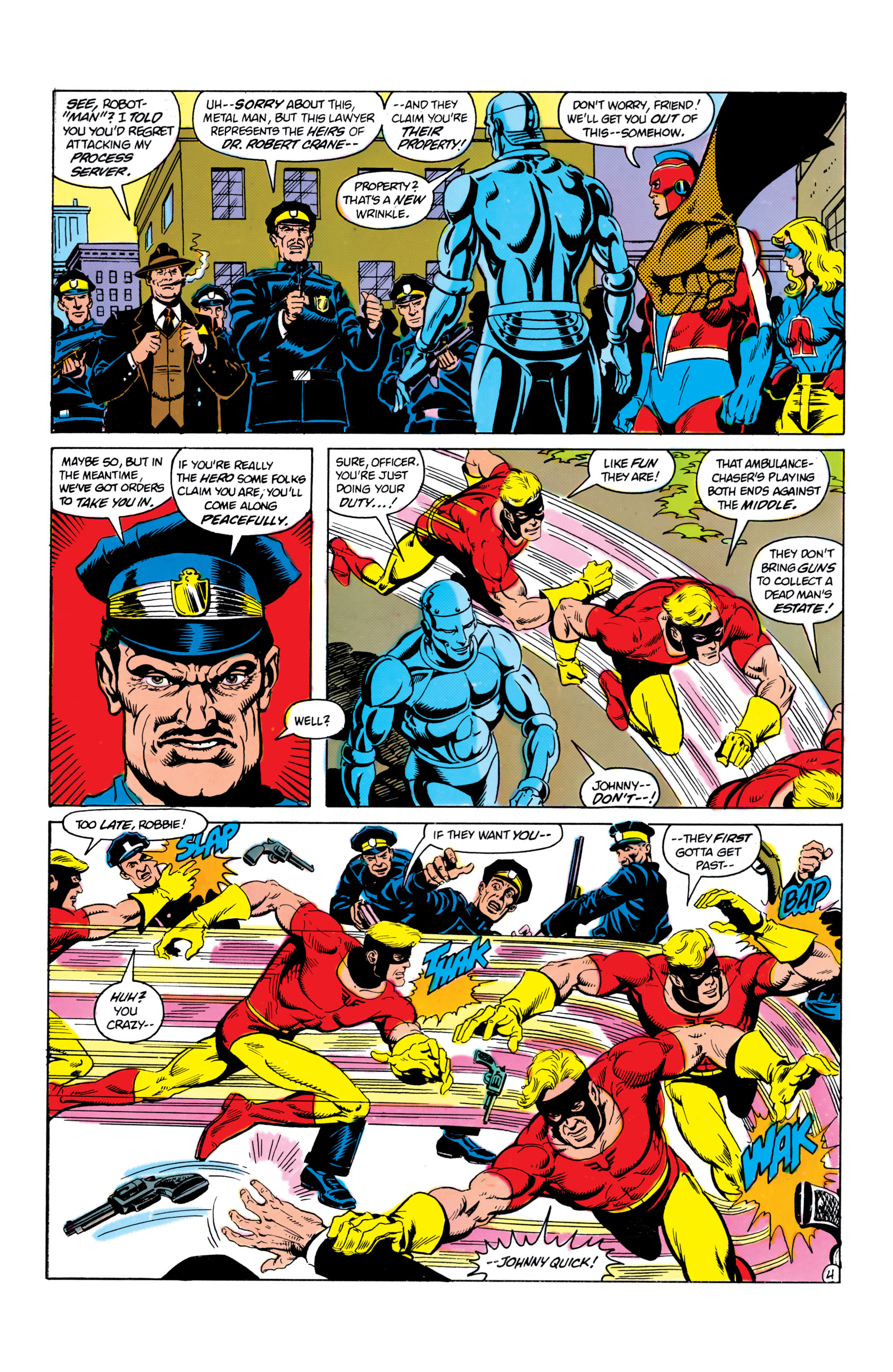 Firebrand lends a hand and melts their service revolvers, until Liberty belle puts a stop to it and Robotman capitulates. Firebrand tells off Libby, but complies. Robotman is chained and taken away, though he tells Grayson to get him a mouthpiece. Johnny tells off libby and runs off, while Libby says Robotman will have to handle it himself. We see people talk about the case and the plaintiff's lawyer, Sam Slattery, pay off a "witness" to commit perjury and claim Robotman kicked a crippled newsboy (must e Freddy Freeman). Robotman is locked in a cell and then opens his chest and pulls out his Paul Dennis mask and suit and pulls open the bars and walks past the guard, who doesn't question where he came from. he meets up with his lawyer and the All-Stars, who show him affidavits from Steve Trevor, Libby Lawrence, the All-Stars, Prof Napier and others. 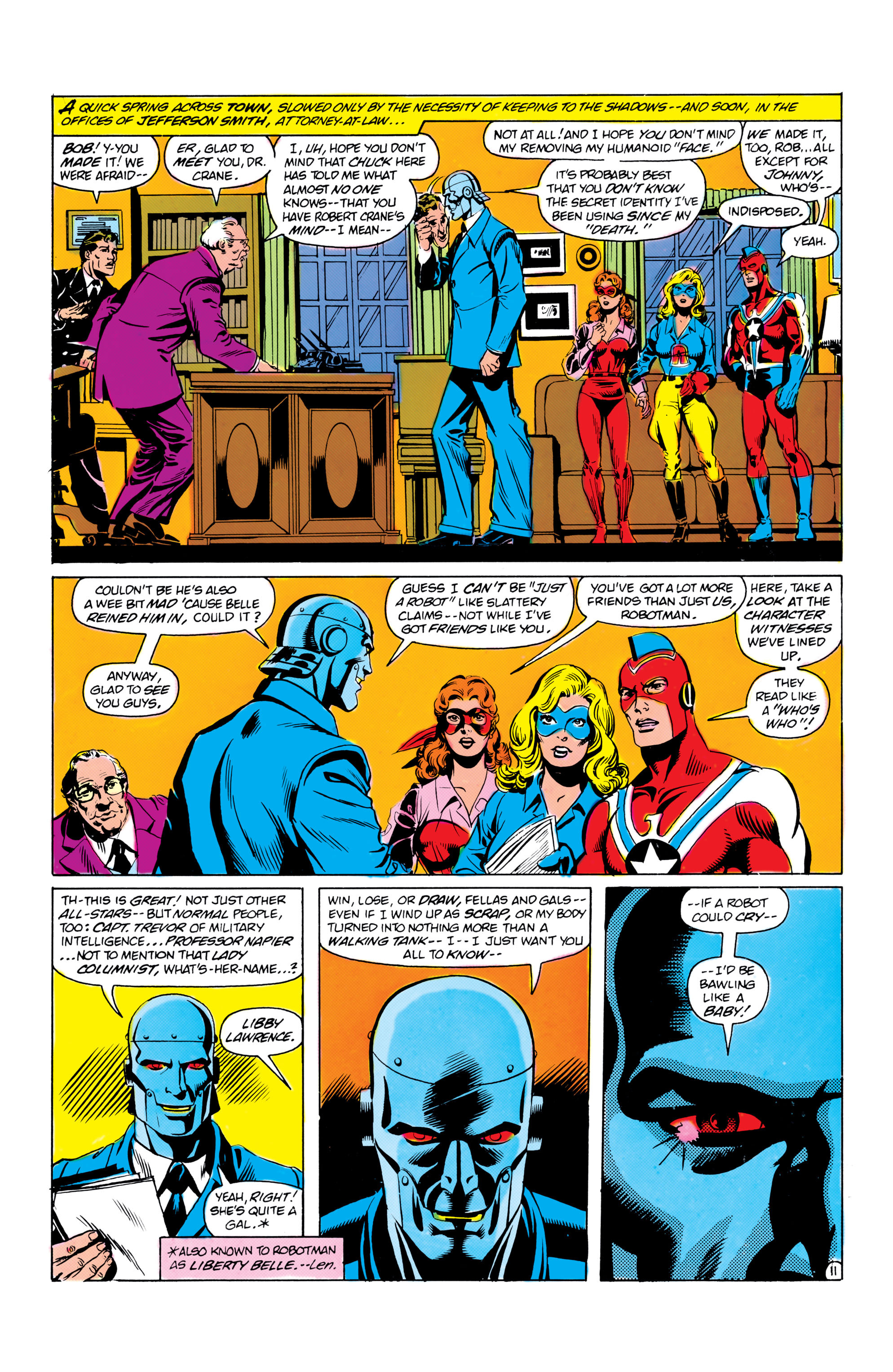 Libby Lawrence makes an appeal for people to withhold judgement and look at facts. Johnny Chambers is in a bar and is accosted by a drunken lout and switches to Johnny Quick and lays him out. he then heads to the court to make sure Robotman stays free, one way or another. At the courthouse, the place is packed and the trial begins, with comment that the building is old and rickety. The All-Stars testify, but Slattery objects to testimony from masked individuals, which is sustained (even if that should have come on the first witness, not after three live and 3 on paper). Johnny thinks Slattery will come after them, next (bit of a stretch). Bob Crane's fiance is called to the stands and Slattery tries to twist her words in to creating a hearsay connection between Robotman and Bob Crane's death. His lawyer gets his turn, though not in cross-examining witnesses, but in bringing in new witnesses. Chuck Grayson relates Robotman's origin. Grayson reveals that Bob Crane's brain was put inside Robotman's body. Joan Carter finds out the truth for the first time. Robotman speaks his peace and Johnny departs. The ceiling starts to collapse and Robotman snaps his chains and braces the roof until the others can get the crowd to safety. 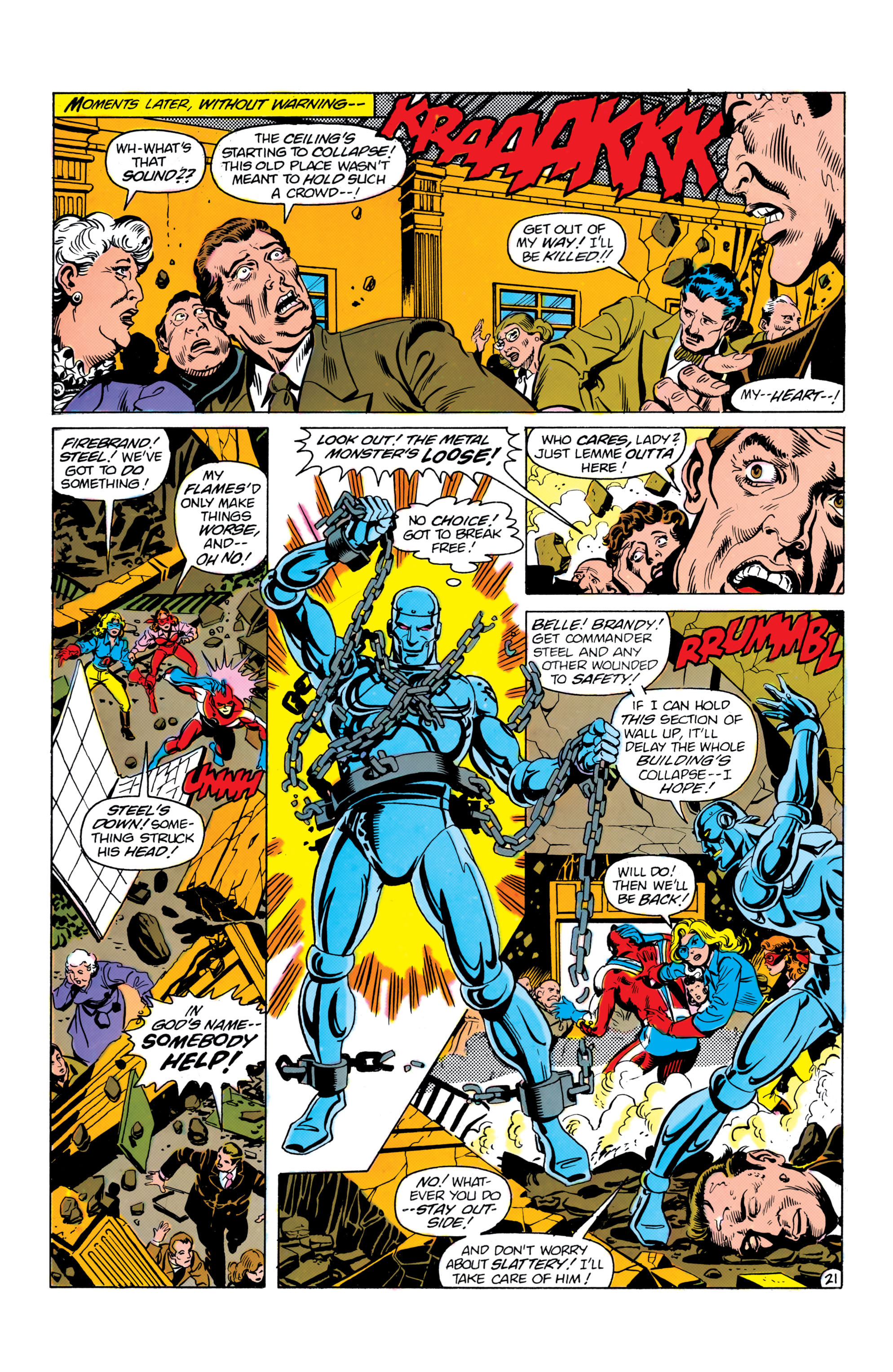 Slattery collapses and robotman speeds him to safety and the court rules that he is human, since he was capable of self sacrifice, even for an enemy. Outside, Johnny Quick joins the team and Miss marple...er, Libby, reveals that Johnny was responsible for incapacitating Steel, so that Robotman could save the day. They head off when a Dr Henry King asks for their help. Libby brushes him off and they move on. he removes a hat to reveal that he is Brain Wave and they will be in trouble. Thoughts: Eh, I kind of have mixed feelings on this one. It's a nice idea; but, I'm not keen on the execution. It adapts the Star Spangled Comics story, from issue #8 (and changes the name of the shyster), which in itself was cribbed from Otto Binder's "The Trial of Adam Link. Okay, technically, that was Earl and Otto, writing as Eando Binder. Adam Link was their robot character from classic sci-fi stories of the 30s and 40s, of which Roy Thomas was a great fan. Binder also wrote Captain Marvel, for Fawcett and would later write Superman, for DC. The plot is pretty much note for note. The stories title, "To Slay the Body Electric," is a twist on Walt Whitman's poem of that title. The title was also used for a collection of Ray Bradbury stories, which includes a story about a robot grandmother brought home to care for three children, after the death of their mother. They all pick elements of her design and she is built and they come to accept her, except the youngest, Agatha, who says she will leave, just like their mother. Agatha runs out of the house in tears and into traffic. The grandmother pushed her out of the way and is hit by a car. Agatha cries and is comforted by the grandmother, who says not even death can take her away. Agatha accepts her. The story was a script for the Twilight Zone and was later a tv movie, The Electric Grandmother, with Maureen Stapleton. In one panel, Robotman say he would cry, if he wasn't a robot, which is a nod to Roy's classic Avengers story, where the Vision is made a member, called "Even an Android Can Cry!" The trial takes a lot of license with legal proceedings, despite Cara Conway's advice. Robotman chased of a process server in a previous issue; but, a robot cannot be presented with legal papers if it is not human. The police could impound robotman, for determination by trial. The lawyers never cross-examine and Slattery's objections to the masked heroes comes after three have testified and sworn statements are being read in. The objection would have had to have been made with the first witness or it would seem unlikely that a judge would sustain later objections. Robotman makes a statement at the start, which would only be allowed during opening arguments. Masked heroes would likely not be allowed to testify without revealing their true identity. Later comics addressed this idea at both DC and Marvel, providing legal precedents. Roy has FDR decree that the courts had to decide Robotman's fate, even though Robotman could have been declared a Federal asset, as a member of the All-Star Squadron. It's a bit of a cop out to stick to the original story. Historical Notes: It is ironic that Robert Crane is the name of the murdered scientist whose brain was put into Robotman's body. Actor Robert Crane, star of the tv show Hogan's Heroes was found dead, in a motel room, murdered. The movie Autofocus revealed the sordid details of his sex addictions, his videotaping of sex acts, and a probable suspect in the killing, in his partner in these seamy practices. However, the crime scene was badly compromised and charges were never brought. Johnny Quick references Joe Palooka, which was a hugely popular newspaper strip, created by Ham Fisher. palooka was the heavyweight champion and the humorous strips dealt with his fights and life. It was ghosted by Moe Leff, who would only be credited on the strip after Fisher's suicide. Al Capp also ghosted on the strip and introduced a hillbilly, called Big Leviticus, who was a prototype for Li'l Abner. When Abner was a success, Fisher claimed creation and brought back leviticus and the hillbilly characters Capp created and called Abner the imitation. Capp made fun of Fisher in his strip, including parodying a facelift by calling a horse Ham's Nose Bob. He wrote a scathing article in The Atlantic, called "I Remember Monster," where he aired all of his grievances with Fisher, without naming him. Fisher retaliated by forging pornographic pictures on Abner panels and alerted the authorities, only to be undone when Capp produced the original art. Fisher tried it again and was caught and expelled from the National Cartoonists Society. After that and the destruction of his mansion, in a storm, Fisher committed suicide. Palooka was adapted into comic books (from harvey Comics) and a feature film , with Stuart Erwin and Jimmy Durante, then a tv series in 1954. Newspapers in the story feature the chained Robotman compared to the Boris Karloff Frankenstein, which featured much the same. Frankenstein would factor heavily in Robotman and the later Incredible Hulk (along with Dr Jekyll and Mr Hyde). A crowd member references the robot displayed at the 1939 World's Fair.  The robot was created by Westinghouse and called Elektro, the Moto-Man. It could smoke, answer questions and even hurl insults, while putting on a 20 minute performance. The robot will be featured in theis series, down the road, as will other artefacts from the Fair, which I will cover when we get there.
|
|
|
|
Post by codystarbuck on Apr 5, 2020 15:28:07 GMT -5
All-Star Squadron#18 Someone is revisiting his past work again! Creative Team: Roy Thomas-writer, Adrian Gonzales-pencils, Rick Hoberg-inks, John Costanza-letters, Gene DeAngelo-colors, Len Wein-editor Synopsis: Johnny Quick is out racing around, blowing up the ladies' skirts so he can admire their legs... 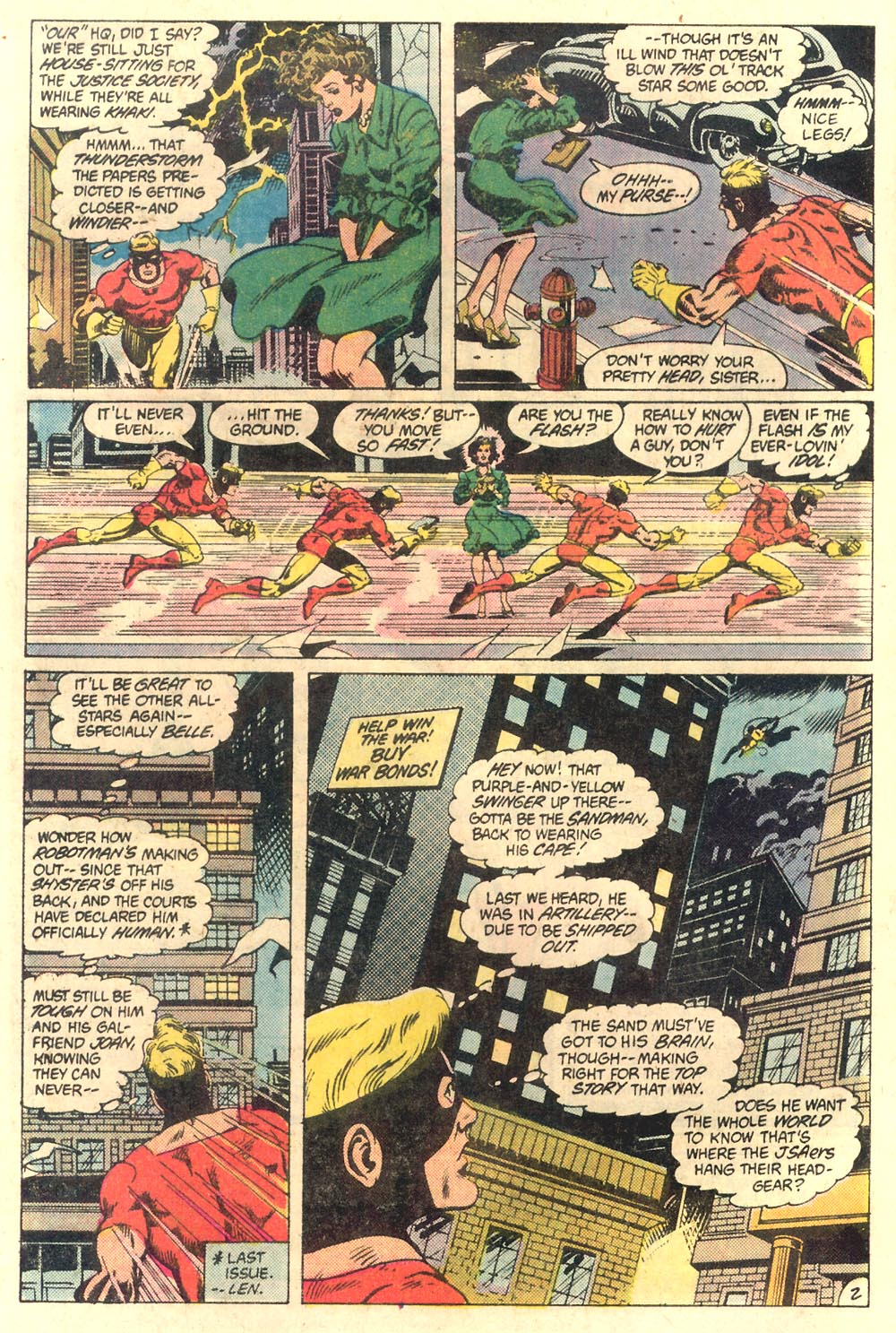 Okay, it's actually a weird storm that is raising the wind, though he was ogling her legs! He spots the Sandman swinging from a rooftop and notes he must have added back his old cape. A gust of wind catches the Sandman and dumps him. Johnny creates an updraft while a radio reporter asks stupid questions about the JSAers being 4F. Sandman fires a pistol that launches a line through a window and he slips inside. Johnny is ticked because Sandman screwed up in front of the annoying reporter, while he is taking shots at mystery men. Johnny moves on to the JSA mansion and finds that Sandman is not who he thought, as he is introduced to the Tarantula. 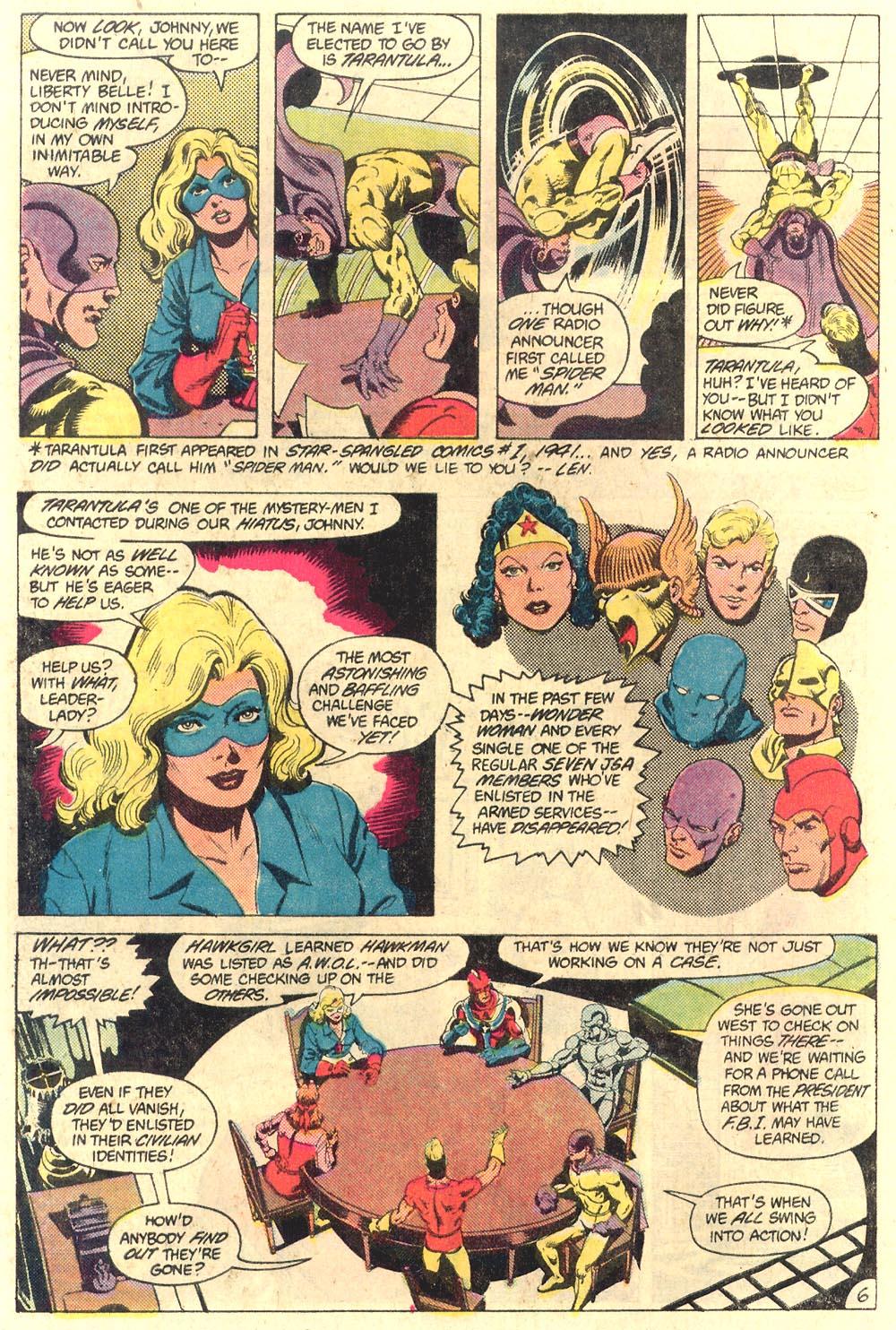 Liberty Belle tells him that JSAers have disappeared from the armed forces and they are going to investigate. Meanwhile Tarantual gives us his origin story... 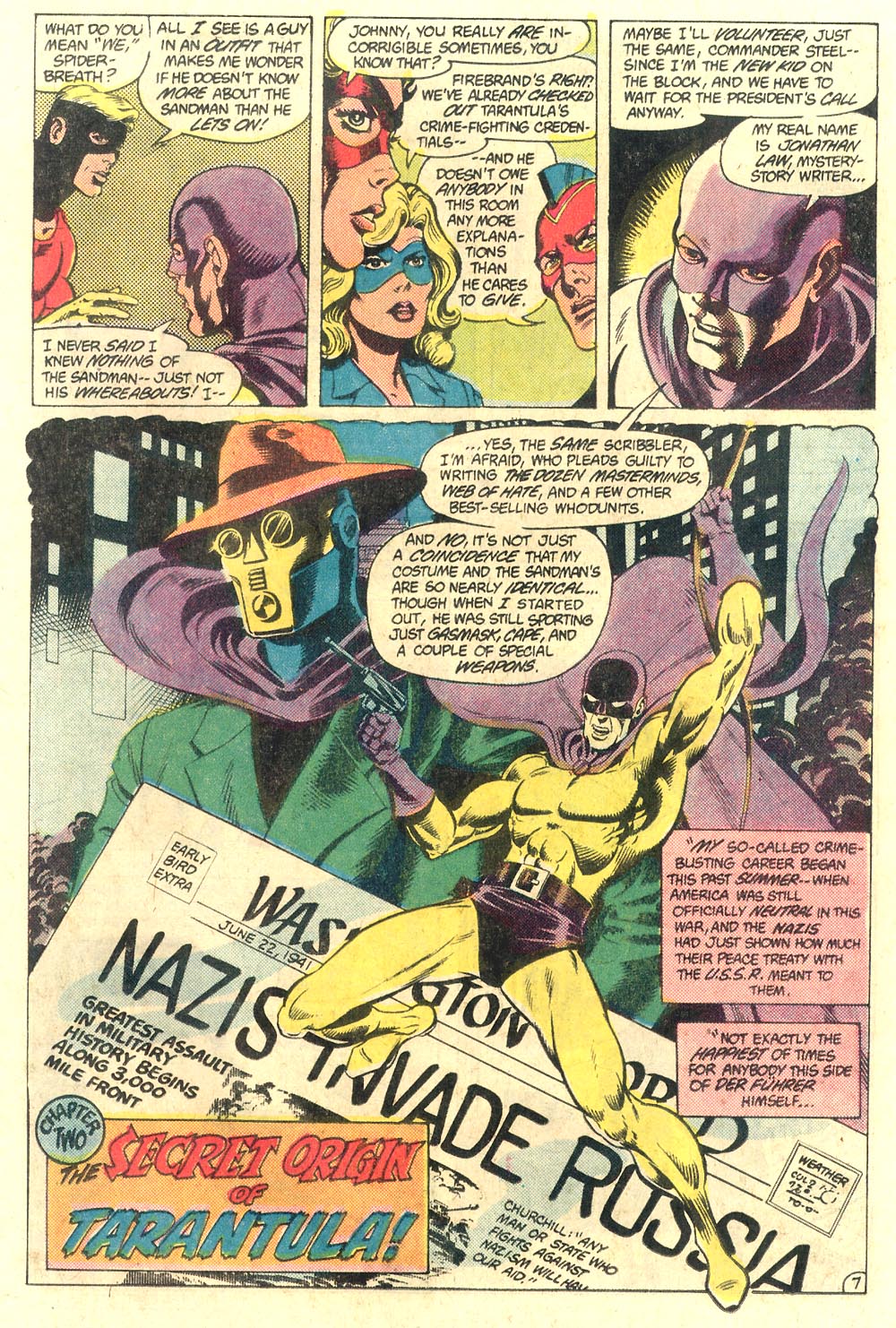 He is Jonathan Law (John Law, get it?), a crime reporter and novelist. He met Dian Belmont while researching a book on the new mystery men, when she showed him a sketch of a costume design she had for Sandman, jokingly saying he is color blind. Later, Dian is staying as Wesley's place and hears a new report that could use the Sandman; but, Wes is out of town. Dian does a bit of cross-dressing and goes out as the Sandman. She is nearly killed by Nazi saboteurs and is saved by the Tarantual, as John Law had a costume made and some gadgets, inspired by the book he is writing. 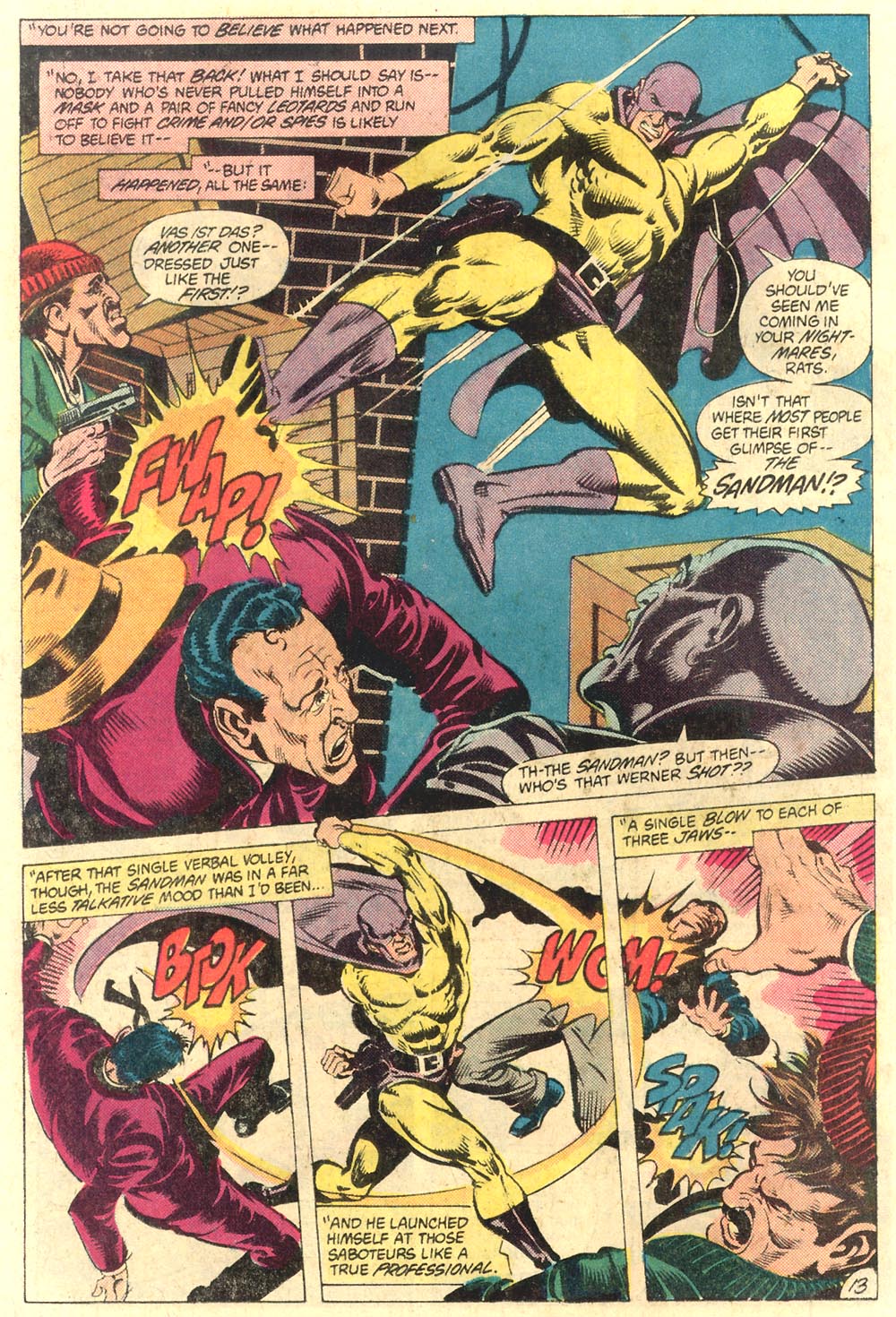 Then, the real Sandman turns up! Dian is killed (uh, no...) and Sandman vows to stay with her costume, though he loses the cape and acquires a sidekick and much better art from some guy named Kirby. Wesley Dodd is among the missing JSAers, so Tarantula turned up. Then, Thor-but-not-"Thor" turns up and smashes the place. 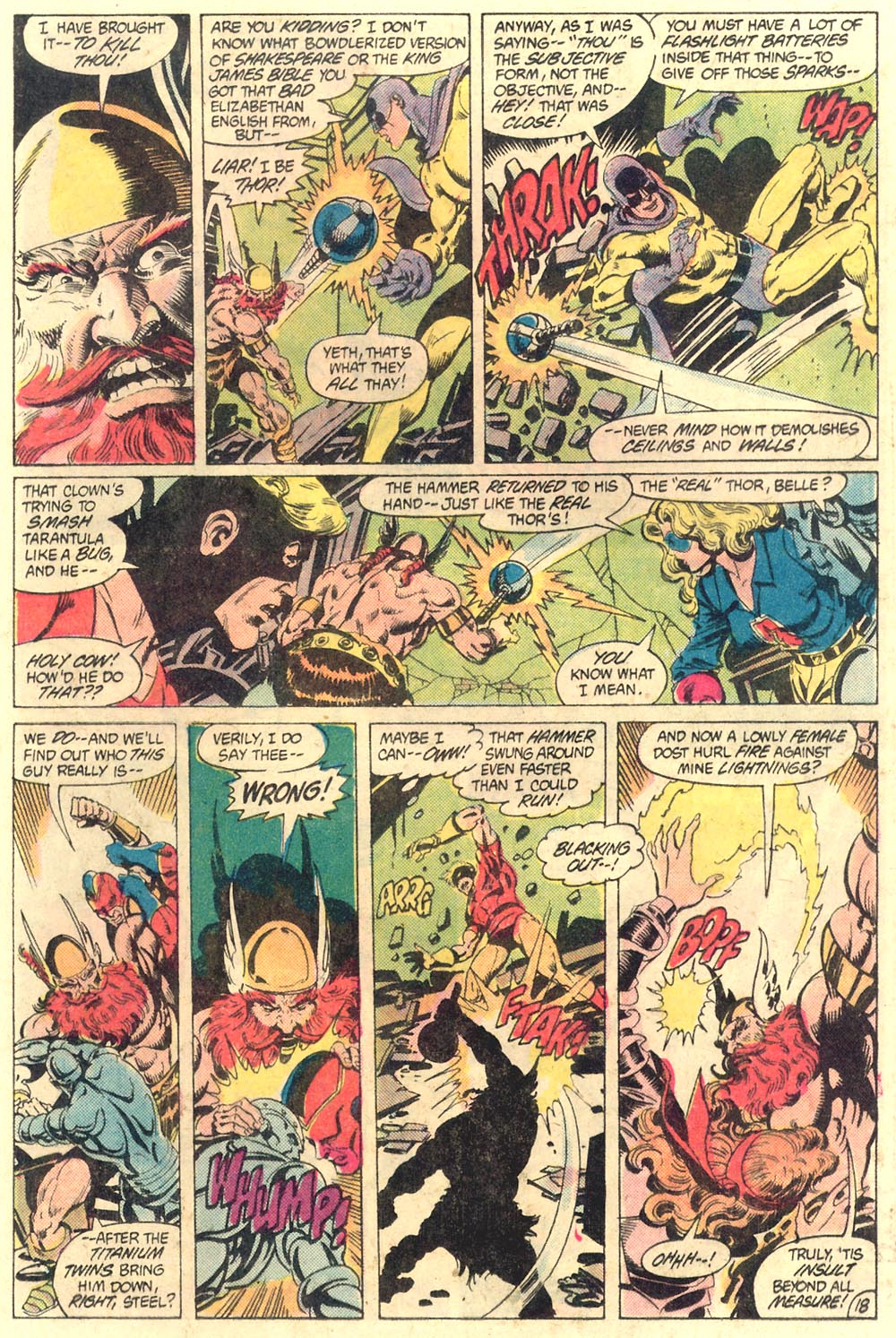 He's looking for Sandman; but, Tarantula will do. He tries to fight and finally manages to zap Thor with a Sh-uh, crap-ton of volts. 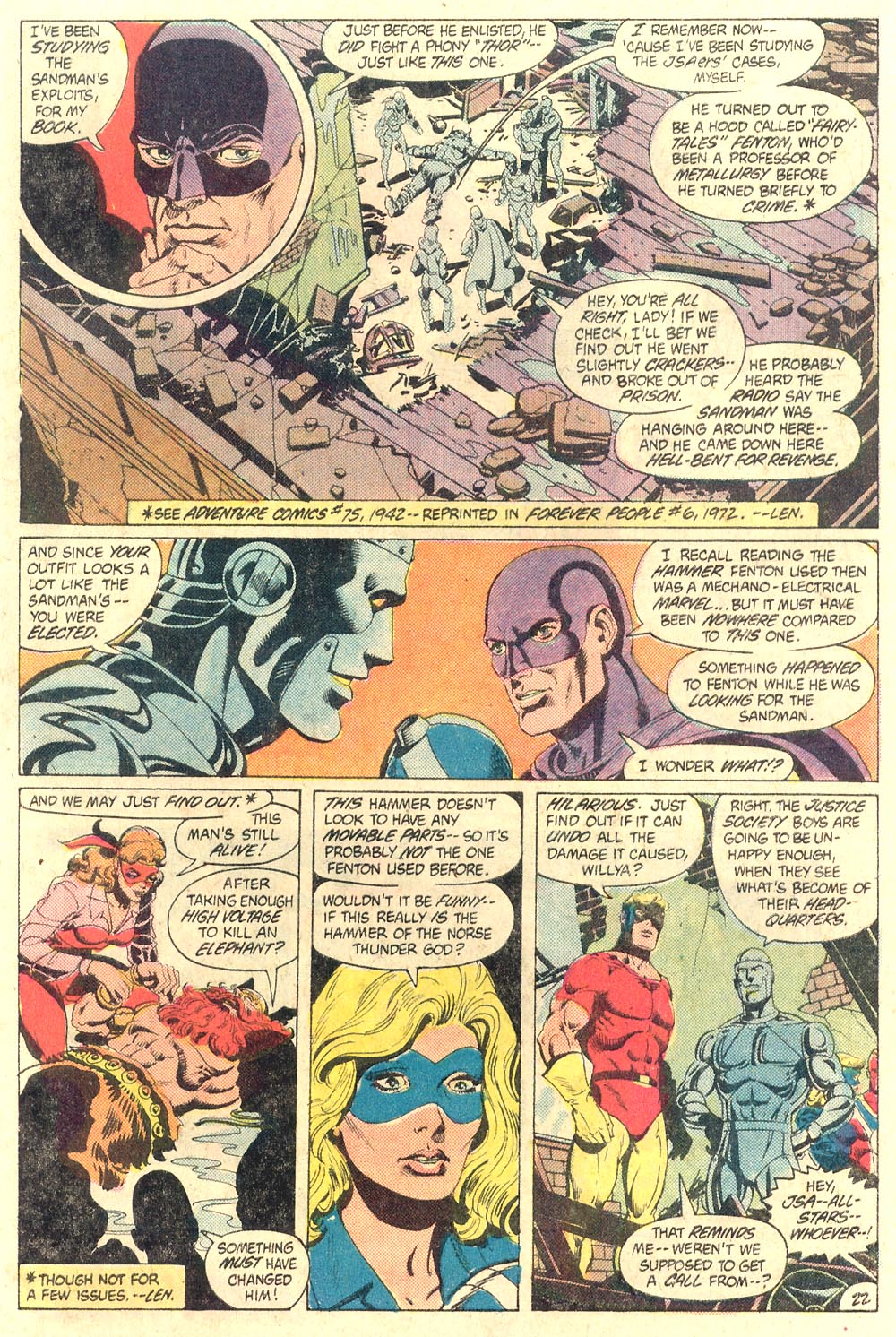 Sandman had fought some did in a fake Thor outfit, but this dude's hammer isn't mechanical. Meanwhile, our nosy radio reporter tells them that someone is beaming a Morse Code challenge to the All-Star Squadron, from the Trylon, at the sight of the New York World's Fair. Thoughts: So, Roy Thomas concocts a story to explain why the Tarantula's costume looked like the Simon & Kirby Sandman costume and kills off Dian Blemont, in the process. She had been written out of the strip when Simon & Kirby came on board; so, there was nothing to contradict this. However, it did a disservice to Dian, who was more of an equal partner to the Sandman, a Margo Lane to his Shadow, rather than a Lois Lane to his Superman. Thankfully, Matt Wagner rectified that and James Robinson continued it. So, a fake Thor. Well, technically, Donald Blake ain't the "real" one, either. Sandman did fight a Thor, in Adventure Comics and Thor, in myth, is noted to be a redhead. Roy later introduced a red-headed Thor, when a documentary camerman is tricked by Loki and ends up with Mjolnir (with some funky gauntlets) and causes some trouble. I just think Roy has some prejudice against ginger Norse. No Ordster. Hoberg is fine, if a bit less developed, technically; but, he can ape the Golden Age look. The story is a bit disjointed, with a mystery disappearance, an origin tale, and a fight with fake-but-not gods all thrown at us. Then we end with a tease for Brain Wave, at the World's Fair grounds. Lot to digest and some odd changes in direction. Roy needs to pace himself a bit. Historical Notes: Only thing of note is a newspaper headline about the Nazis invading the USSR. Hitler had stated he would invade Russia, in Mein Kampf and spoke of the need for the Ukraine and other areas for farmland, for the Fatherland. He also spoke of racial wars with the True Aryans standing up to the Slavic peoples, likening them to the Mongol Hordes and the Huns. The Wehrmacht was heavily indoctrinated in anti-Slavic and anti-Semitic propaganda, as were the general populace, despite revisionist histories that try to make the Wehrmacht seem blameless in Nazi aggression and terrorism. In 1939, Hitler and Stalin signed a non-aggression pack, which allowed Hitler to make a move on Poland. The pact had secret provisions that divided up Eastern Europe. When the Germans invaded Poland, the Russians moved into the Eastern end and the two powers divided the country. The Germans got raw materials from the Soviets, while the Russians got trade goods and weapons. Hitler used this time to turn his attention to the west and France. Once he had secured Western Europe, he decided to turn back to the Soviets and implement his racial aims. When Germany made its pact with Italy and Japan, the USSR was concerned about German interference in their sphere of influence, where Japan was already a rival. Germany sought to have the USSR enter their pact, but did not address the concerns about interference. The Soviets thought they had greater military might than Germany, while the Germans thought the top Soviet military leadership had been eliminated in the purges. The Wehrmacht began planning for an invasion in late 1940. The Germans then started massing troops in staging areas all along the Russian border, moving 3 million Germans and another 600,000+ Axis soldiers. The invasion was planned for May, but was delayed a month for reasons that are hotly debated. On June 22, 1941 the Germans launched Operation Barbarossa. The Russians weren't stupid and had also been planning on war with Germany, upping production of weapons and developing their own battle plans. The Germans poured across the border and the Luftwaffe went against identified targets of supplies, troop concentrations and airfields, gaining air superiority by the end of the first week. However, it couldn't control all airspace and was at 70% strength. Early German victories were hard won, especially at Kiev. Germans threatened Leningrad and Moscow, but the Russians fought delaying actions as the season progressed into colder weather and increased rains and frost and snow. Winter saved Moscow. The Soviets launched counter-attacks in December that helped secure Moscow. Slowly, the Russians fought and gained strength. Leningrad and Stalingrad faced prolonged sieges and house-to-house fighting. The Germans launched a new offensive in the spring of 1942, aiming for the oil fields of Baku and gained much ground; but, their resources were stretched thin. The Russians moved industrial production east and started churning out tanks and aircraft to fight back. The Siege of Stalingrad was lifted by Feb 1943. By 1943, the Russians were at full production and outstripping the Germans. They already had advantages in the size of their population and natural resources. They pushed the Germans back. The Germans launched another offensive in Summer 1943 and met 2.5 million Russians and gained little. By mid 1944, the Russians had reclaimed their territory and were moving westward. By May 1945, they were at the Reichstag, in Berlin. In Russia, World War 2 was known as the Great Patriotic War; a fight for their homeland. It ignores Stalin's complicity with Germany, prior to 1941; but, then again, much the same can be said of the west in their histories. The greatest death tolls were on the Eastern Front, on both sides, not to mention civilian deaths due to direct fighting, starvation and the Holocaust. It was a fight for their very existence, in their eyes and it is hard to argue. We will cover the 1939 World's Fair, soon, as it takes center stage in this book.
|
|
|
|
Post by codystarbuck on Apr 5, 2020 15:32:31 GMT -5
ps This is Adrian Gonzales' swansong for the series, as we get a brand new penciler next issue; and, what a penciler!
|
|
|
|
Post by Prince Hal on Apr 5, 2020 15:47:09 GMT -5
codystarbuck, another fine review, and just to follow up on the history section, a question based on your obviously extensive reading, research, and knowledge. If there is a way to rank the worst combat to have experienced in World War Two, would you nominate Stalingrad in Particular and the Eastern Front in general as being at or very near the top of the list? Again, there's probably no combat worse than whatever a particular combatant is seeing at the time, but strategists and tacticians, as well as soldiers, professional and conscripted, probably have thoughts about this.
|
|
|
|
Post by codystarbuck on Apr 5, 2020 16:21:08 GMT -5
codystarbuck , another fine review, and just to follow up on the history section, a question based on your obviously extensive reading, research, and knowledge. If there is a way to rank the worst combat to have experienced in World War Two, would you nominate Stalingrad in Particular and the Eastern Front in general as being at or very near the top of the list? Again, there's probably no combat worse than whatever a particular combatant is seeing at the time, but strategists and tacticians, as well as soldiers, professional and conscripted, probably have thoughts about this. I'm no expert and have only been stateside, during a war. The street fighting in the cities along the eastern Front were brutal and the atrocities on both sides immense. it was probably the worst for the civilian population, though I suspect the Chinese might beg to differ. Those who fought in the Pacific speak of the fact that the Japanese would not surrender and they would fight wave after wave of banzai charges, burn the soldiers out of tunnels and bunkers and that theater amassed a lot of Purple Hearts. I suppose it depends on which you personally find more horrific. the Russians and the Germans would at least surrender and there was a chance at survival in the POW camps (not much; but a chance). The Japanese didn't take a lot of prisoners, after the early days and they cared less about the Geneva Convention than the Germans or Russians. Stalingrad was pure hell for the poor Russian footsoldiers who had to try to fight with little weaponry and possible execution by political officers if they didn't die heroically in the process. For the people, it was worse, as at least the soldiers could fight. Which is a worse death; a bullet or bomb fragment or slow starvation and disease? Every time I hear some company, military officer or scientist say this technology will make war impossible, I want to hit them with a history book. Preach on Brother Edwin! |
|
|
|
Post by mikelmidnight on Apr 6, 2020 12:11:53 GMT -5
So, Roy Thomas concocts a story to explain why the Tarantula's costume looked like the Simon & Kirby Sandman costume and kills off Dian Blemont, in the process. She had been written out of the strip when Simon & Kirby came on board; so, there was nothing to contradict this. However, it did a disservice to Dian, who was more of an equal partner to the Sandman, a Margo Lane to his Shadow, rather than a Lois Lane to his Superman. Thankfully, Matt Wagner rectified that and James Robinson continued it.
This passage was a huge peeve of mine when Roy did it. Killing off an engaging character simply to 'explain' why she's not around in the S&K strips did her a huge disservice. Also, while it didn't strictly violate continuity, it did cause some problems:
1) the gist of the story was that Dian wanted to know what it was like to be a mystery(wo)man, and she wasn't very good at it. That sits awkwardly with the early story in which Wes Dodds had been kidnapped ... and Dian dresses up as the Sandman in order to rescue him.
2) although she's not named in the story, the 'girl JSA' tale which was published after this did have a girlfriend for the Sandman, and there are no other candidates for the role.
|
|
|
|
Post by electricmastro on Apr 6, 2020 12:28:15 GMT -5
A crowd member references the robot displayed at the 1939 World's Fair.  The robot was created by Westinghouse and called Elektro, the Moto-Man. It could smoke, answer questions and even hurl insults, while putting on a 20 minute performance. The robot will be featured in theis series, down the road, as will other artefacts from the Fair, which I will cover when we get there. Which likely inspired robot characters such as Iron Man (aka Hugh Hazzard). Makes me wonder if Thomas ever considered using him on the All-Star Squadron.  |
|
|
|
Post by Slam_Bradley on Apr 6, 2020 12:30:16 GMT -5
So, Roy Thomas concocts a story to explain why the Tarantula's costume looked like the Simon & Kirby Sandman costume and kills off Dian Blemont, in the process. She had been written out of the strip when Simon & Kirby came on board; so, there was nothing to contradict this. However, it did a disservice to Dian, who was more of an equal partner to the Sandman, a Margo Lane to his Shadow, rather than a Lois Lane to his Superman. Thankfully, Matt Wagner rectified that and James Robinson continued it.
This passage was a huge peeve of mine when Roy did it. Killing off an engaging character simply to 'explain' why she's not around in the S&K strips did her a huge disservice. Also, while it didn't strictly violate continuity, it did cause some problems:
1) the gist of the story was that Dian wanted to know what it was like to be a mystery(wo)man, and she wasn't very good at it. That sits awkwardly with the early story in which Wes Dodds had been kidnapped ... and Dian dresses up as the Sandman in order to rescue him.
2) although she's not named in the story, the 'girl JSA' tale which was published after this did have a girlfriend for the Sandman, and there are no other candidates for the role.
Wagner not only brought her back but made her one of my favorite comic characters of all time. |
|
|
|
Post by dbutler69 on Apr 6, 2020 14:00:31 GMT -5
Personally, I rather liked #18. I thought it was cute how Thomas explained the extreme similarity in Tarantula & Sandman's costumes. Apparently this was originally supposed to be a backup story in the Brave & the Bold.
|
|
|
|
Post by codystarbuck on Apr 12, 2020 19:09:19 GMT -5
All-Star Squadron #19 Cover by Da Ordster! Creative TeamL: Roy Thomas-writer, Jerry Ordway-artist, John Costanza-letters, Gene D'Angelo-colors, Len Wein-editor Ordway begins and penciller and inker. Synopsis: The All-Stars or coming into Queens and the grounds for the 1939 New York World's Fair... 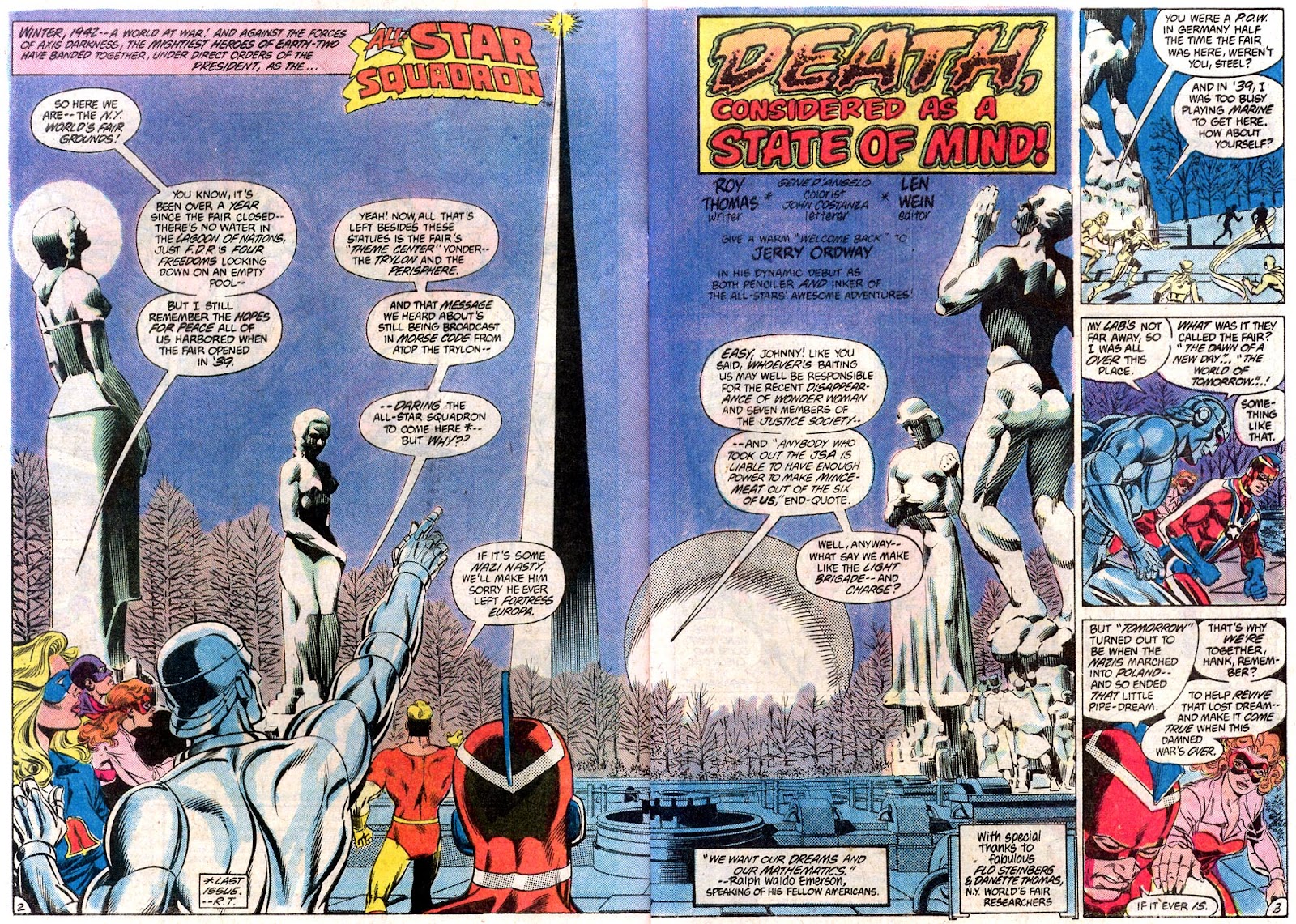 The team was lured out there by a Morse Code broadcast from the fairgrounds; but all that's left are the Trylon and Perisphere and the Four Freedoms statues. Johnny runs up the Trylon, finds it empty and lets the rest inside. The soon find Elektro the robot, which grabs Firebrand and slugs Johnny Quick... 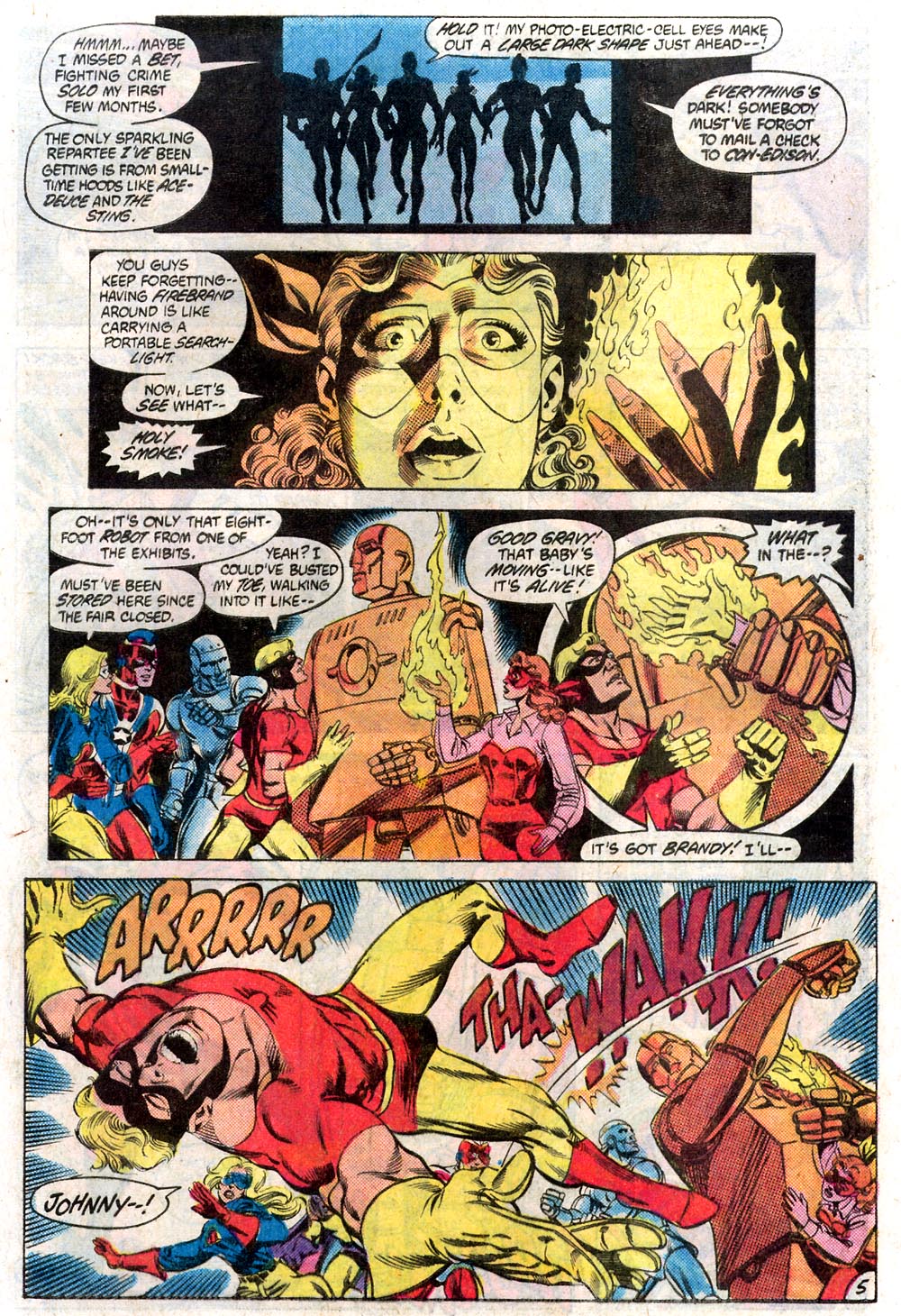 Belle catches Johnny and Cdr Steel and Robotman double-team the robot and defeat it, which leads to a reveal of the comatose JSA.. 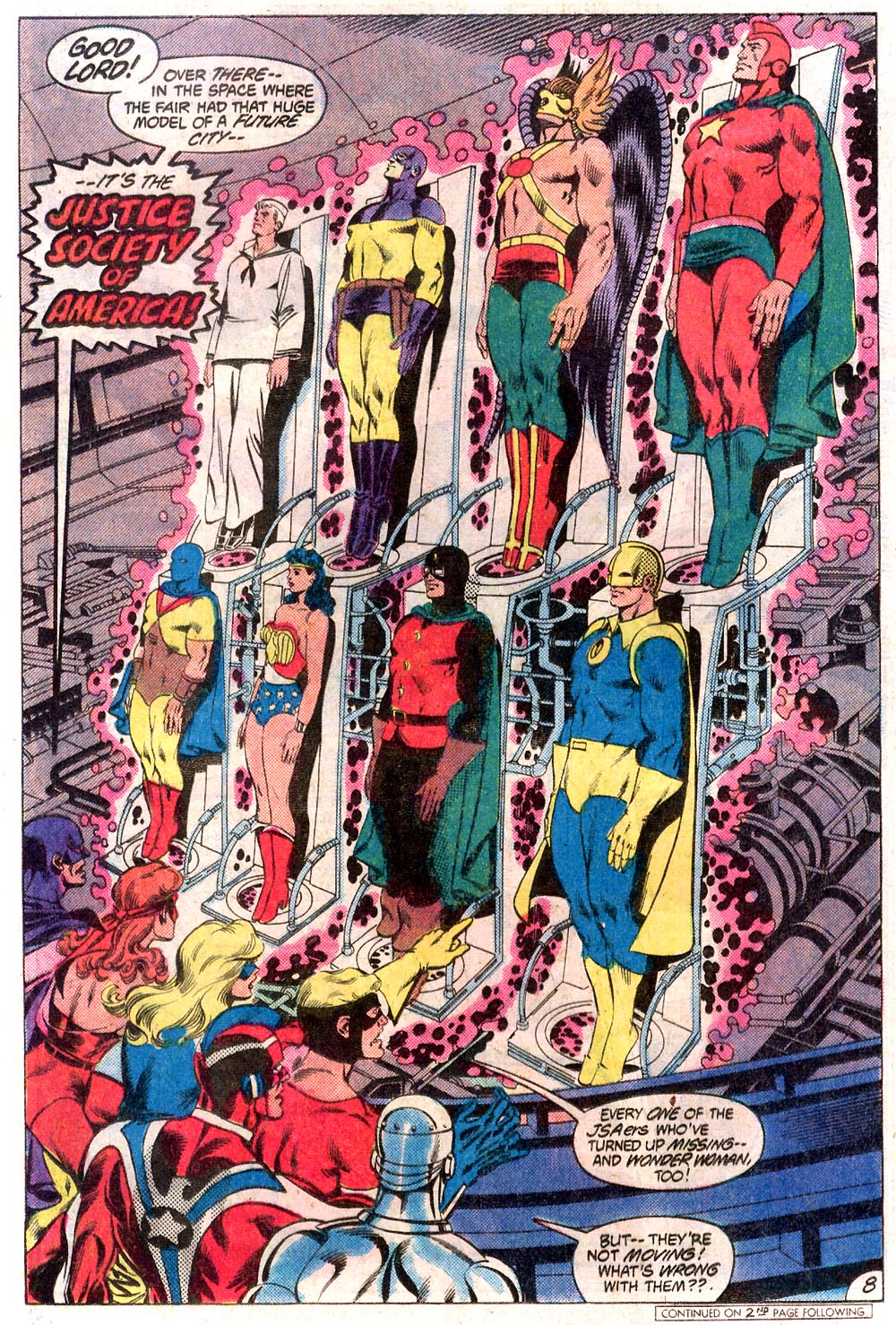 and a hologram of a brain, with Brain Wave speaking remotely. he goads them on with fake images and electronically induced dreams of Hawkman fighting Japanese Zeroes, launching from a carrier, from All-Star Comics #11. The rest fend off the Japanese at Wake Island, the Philippines, off the Aleutians, and then take the fight to Japan, as they are programmed into killing machines. The All-Stars try to free them and get whammied, leaving Brain Waver to cackle.. 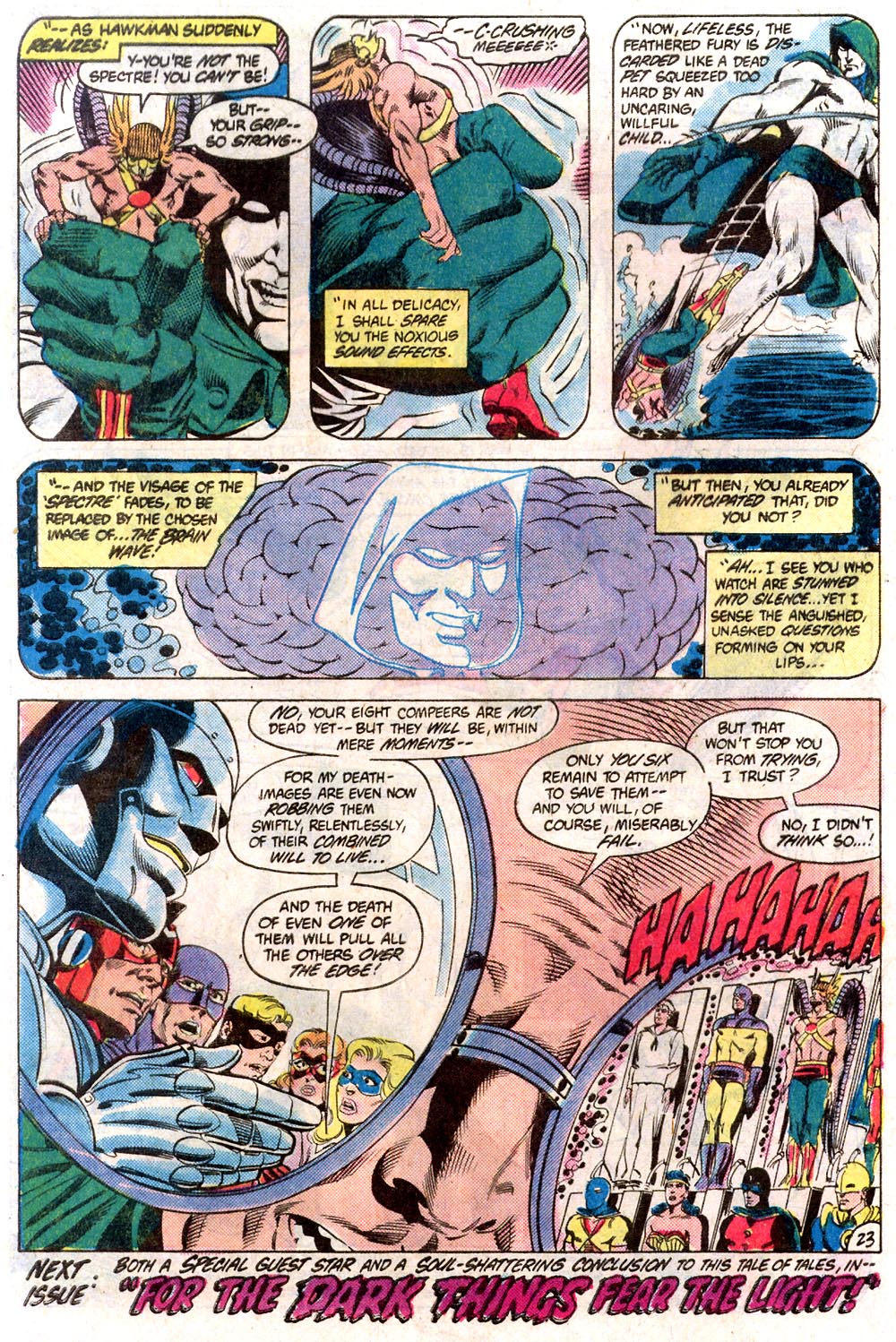 Thoughts: Thoughts: Well, Roy is indulging in his penchant for reliving his beloved All-Star Comics issues. Nothing wrong with that, if it informs the new plot and he uses it here as a dream, to explain away the inconsistencies with actual history; but, he has a tendency to wallow in the past story at the expense of the new. It's mostly under control here; but it would get out of hand in the latter days of Infinity Inc. Right now, we have a classic villain whomping the tar out of the All-Stars, so they are going to have a fight on their hands. Historical Notes: The 1939 New York World's Fair was a massive event, the second most expensive (after the 1904 St Louis one), with the theme of "Dawn of a New Day," though unofficially the World of Tomorrow. It was filled with displays of emerging technology, art deco architecture, cultural displays from around the world, and the central feature of the Trylon and the Perisphere...  The combined pair featured an exhibit, with a diorama of the city of the future, titled Democracity. Entrance was gained through the Helicline, a winding 950 ft long spiral ramp. Inside, the visitors passed through walkways and stared down below at Democracity... 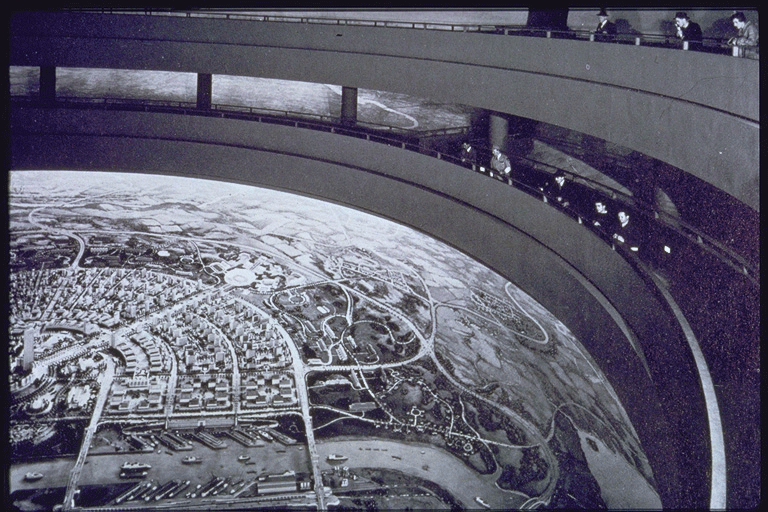 The Fair was split into zones, with different themes. The Communications zone featured displays from AT & T and IBM, with electronic voice speakers, punch-card programmed calculators and more. The Transportation Zone featured pavilions from Ford, Chrysler and GM's Futurama, designed by famed industrial designer Normal Bel Geddes....  Government Zone featured pavilions from several nations, including Japan and Italy, as well as the British Pavilion , with a copy of the Magna Carta. There were amusement rides, food pavilions, advertising and special entertainment attractions. A Superman Day was held, with an actor dressed as Superman...  One of the exhibits was the Westinghouse -created Elektro the Robot, which was programmed for multiple tasks, including lighting a cigarette and delivering comic insults. The Aquacade featured musical amusements that would foreshadow Hollywood musical films...  There was even a Girlie Show, at the Bendix Lama Temple, with a Shangri-La theme. I don't recall that in James Hilton's Lost Horizon! The fair continued into 1940 and was a huge success and a big influence on the later 1964 New York World's Fair. It wasn't all light amusement and idealistic visions of the future. The war clouded the event and the Polish and Czech Paviliaons did not reopen in 1940. Police officers were killed while investigating a time bomb at the British Pavilion. There is some belief that the bomb was part of a propaganda campaign by William Stephenson, aka Intrepid, who was MI-6's man in the US and Canada, stirring up support fro Britain, in neutral USA. The Fair was a last fantasy, as the world emerged from the Great Depression, but quickly plunged into World War 2. The mention of Japanese ships off the Aleutians is premature, as the Japanese would not attack the Aleutians until June 1942, as part of a diversionary tactic that was part of the attack on Midway. The Japanese launched an attack on the air base at Dutch harbor and were soon met by fighters from Ft Glenn and the Japanese Kate torpedo bombers released their bombs and fled, doing little damage. The Japanese returned in force and managed to damage oil tanks, the hospital and barracks barges. Fighters hunted for them, but, bad weather made them lose sight of the Japanese fleet but also prevented a planned invasion of Adak. The Japanese did invade Kiska and Attu, which they then occupied. The Unguax tribe remained there until September 1942, when they were interned in Hokkaido, leading the US to forcibly evacuate the tribes on the other islands. In 1943, the US launched operations to force the Japanese off the islands, with Castner's Cutthroats on Attu, a combined force of the Army and Alaskan native scouts, but lack of proper equipment limited their operations for some time. Kiska was invaded with a force from the 7th Infantry Division, the Canadian 13th Infantry Brigade of the 6th Infantry Division and the 1st Special Services Force, aka the Devil's Brigade, made up of Canadian and American soldiers in a precursor to Army Special Forces. However, the Japanese had extracted their men two weeks earlier. The Allies still suffered over 300 casualties, due to friendly fire, accidents and boobytraps. Attu was far bloodier as the Japanese tried a desperate banzai charge that left 2300 Japanese dead and scores more believed unaccounted for. I read one account of Castner's Cutthroat that, at the end, the Japanese soldiers committed suicide by placing armed grenades under their chins and blowing their heads off.
|
|
|
|
Post by codystarbuck on Apr 19, 2020 16:36:26 GMT -5
All-Star Squadron #20 GL's been busy.... Creative Team: Roy Thomas-writer, Jerry Ordway-artist, John Costanza-letters, Gene D'Angelo-colors, Len Wein-Editor Synopsis: As we last left them, Brain Wave was sapping the JSAers will to live, via mental illusions.... 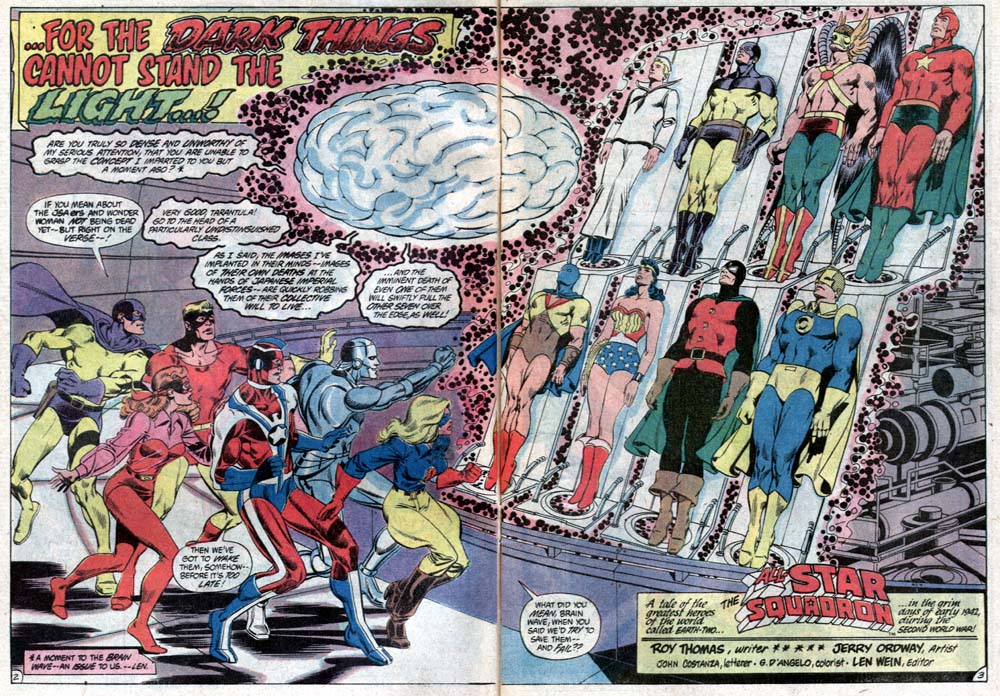 He is out to destroy the JSA to prove his power and challenges the All-Stars to save them. they jump into the energy field and we arrive in Japan... 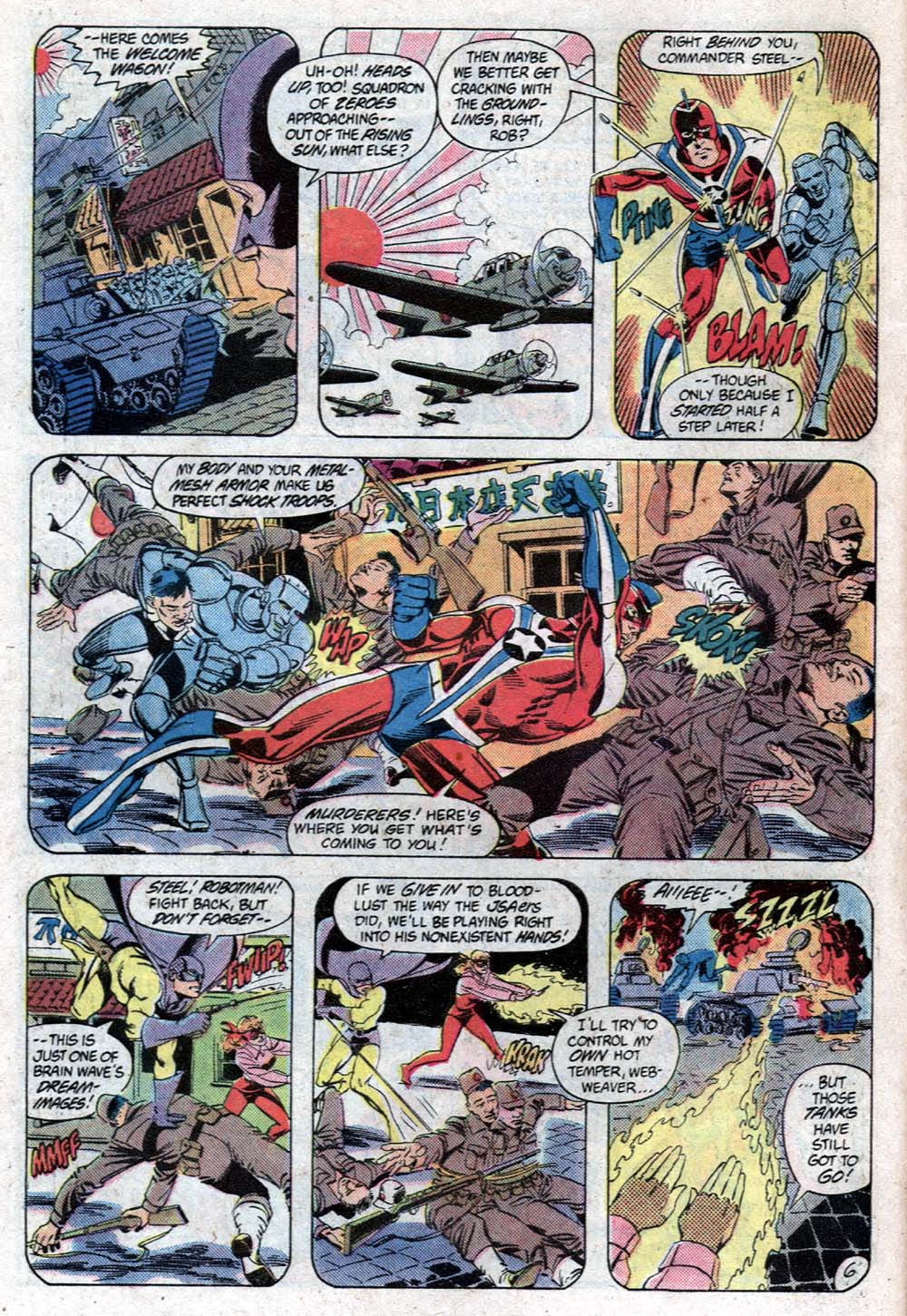 They are attacked by hordes of Japanese soldiers and weapons and go down, one by one, until Liberty Belle is the last, as Brain Wave gloats.. 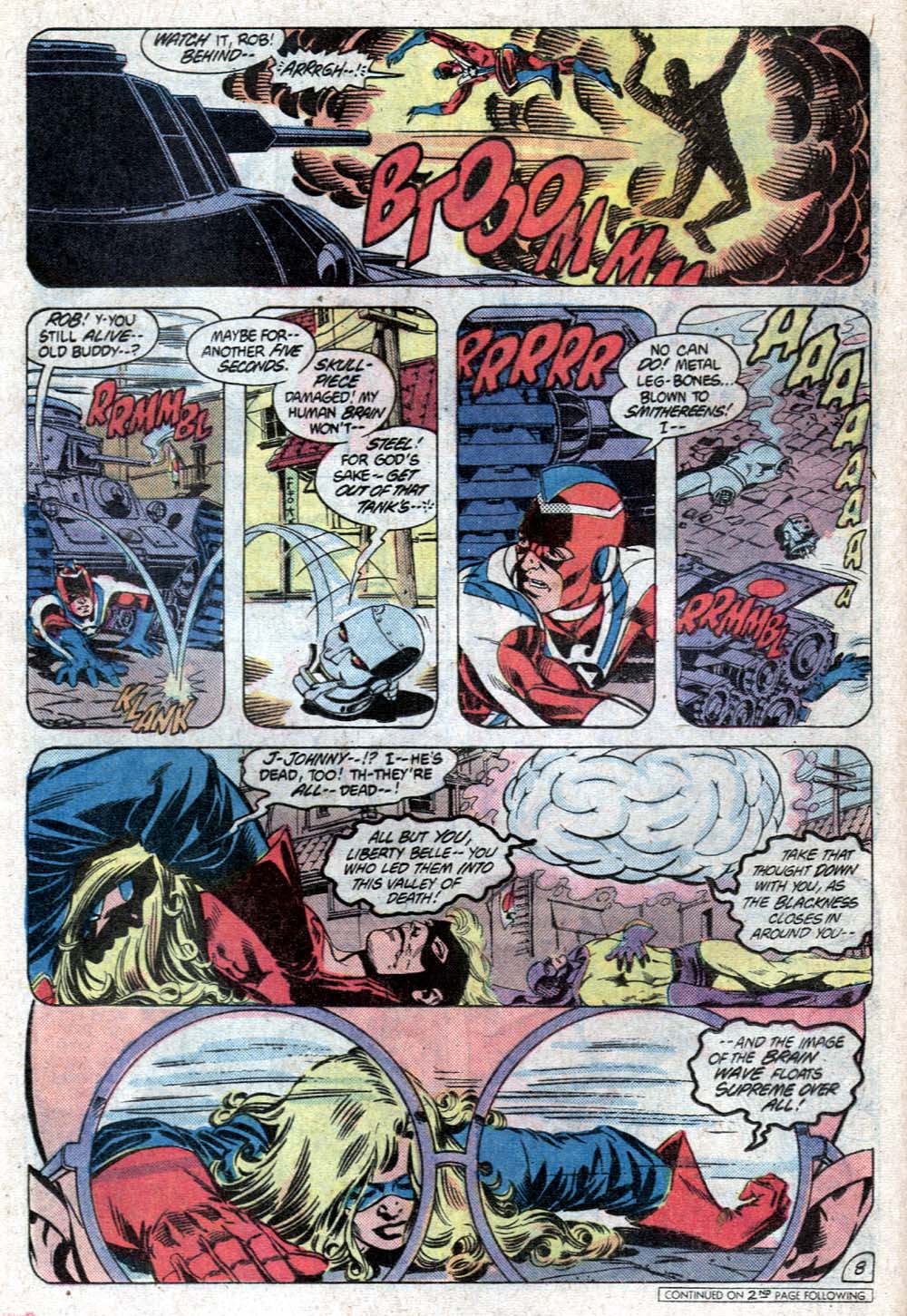 Brain Wave relates his origin and is retroactively inserted into the events of All-Star Comics #8 (debut of Wonder Woman) and relates events when he actually fought the JSA in ASC #15. He put a subliminal suggestion in their heads, which compelled them to gather at the Perisphere (and Wonder Woman, who he met later) and then we catch up with other members, from their own comics (Superman #17, Batman #11, All-Flash #4, and GL#4) GL hears about the All-Stars disappearing near the World's Fair and flies up there and finds the scene and gets dumped into the energy field. he finds their dead bodies and goes mental, using the ring to destroy tanks and planes and men, growing stronger and stronger, as Brain Wave loses control. Finally, GL unleashes unknown power on Japan... 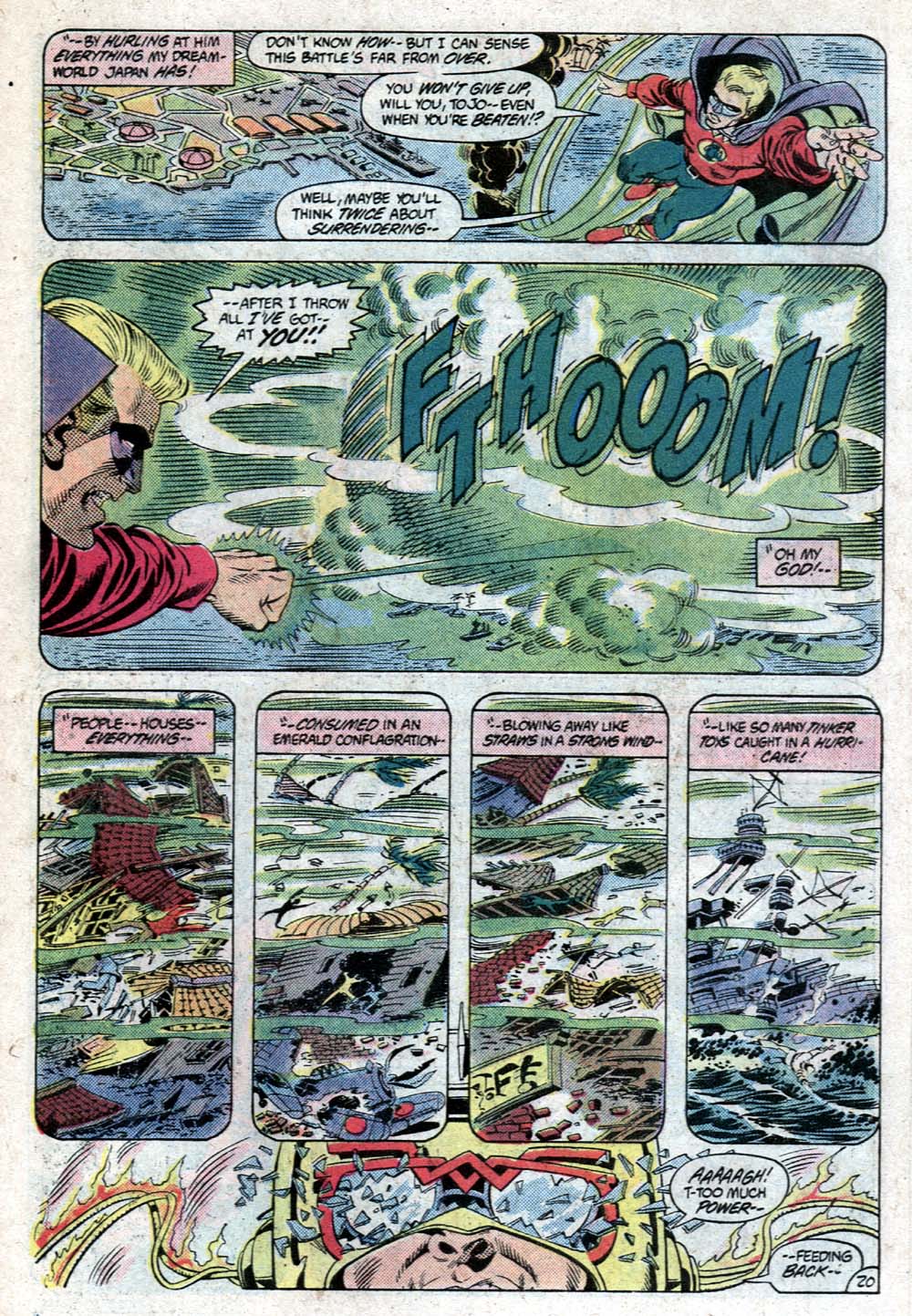 It destroy's Brain Wave's apparatus. GL is overwhelmed by the destruction he has caused. He is about to turn the ring upon himself when the All-Stars stop him, via telepathy. They find him collapsed, quoting from the Bhagavad-Gita... 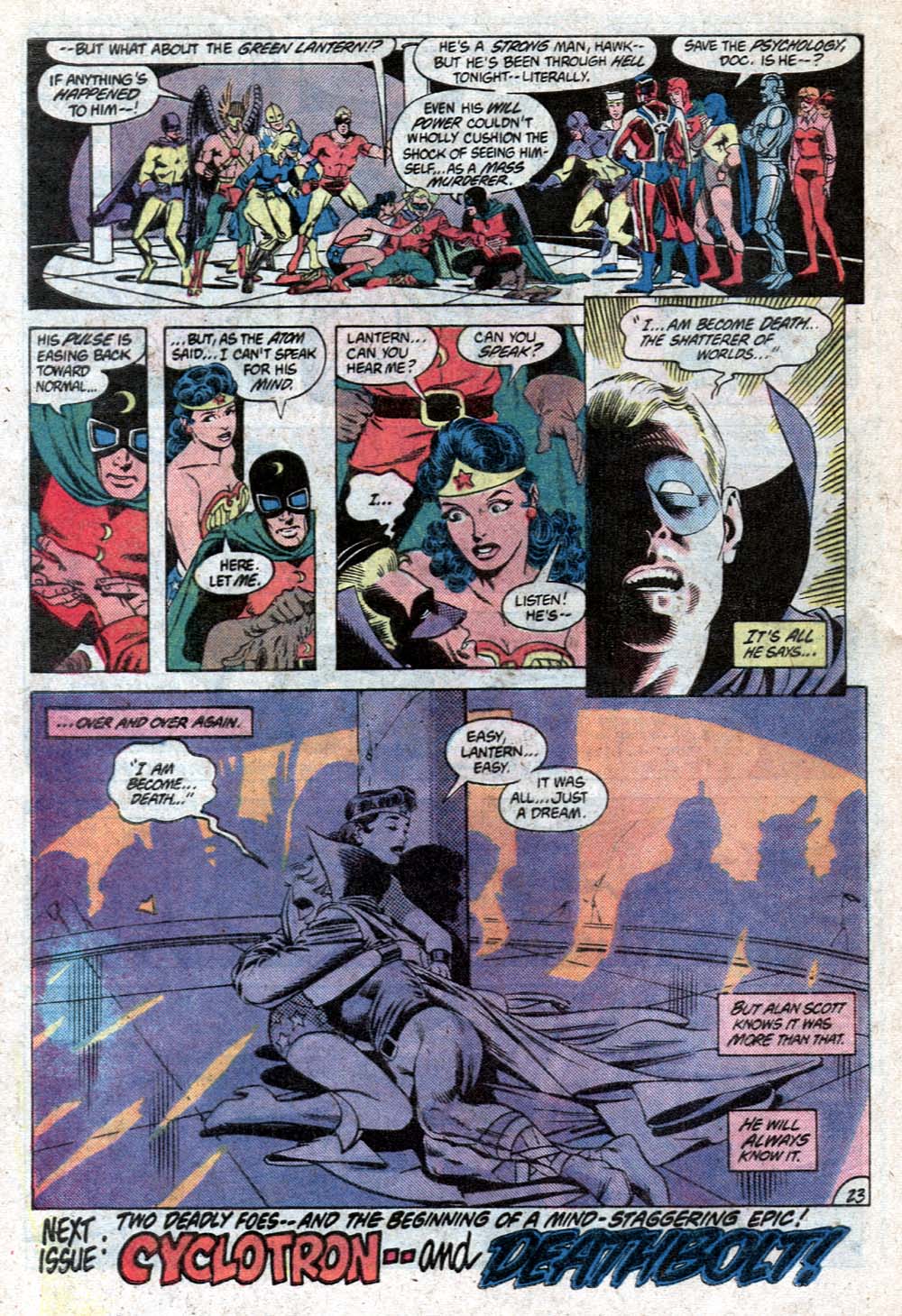 Dick Giordano's Meanwhile column mentions a visit by Brooke Shields (part of a campaign for the American Lung Association, related to childhood asthma) and a mention that JLA/Avengers will be on sale in May. Not if Jim Shooter has anything to say about it....and he did! TM Maple's Earth-X counterpart writes a letter and the Coming Comics says Captain Carrot and the Zoo Crew will meet the Justa Lotta Animals. No word on whether they will cross-over with the Justa Suma Animals or the Apevengers. I want to see them meet the X-Mammals! Thoughts: Again, Roy spends a lot of time rehashing old All-Star issues, which doesn't annoy me as badly here as it did in Infinity Inc, where it got ridiculously out of hand. It does serve to show just how powerful Green Lantern is, if he let himself go. Roy did say, later, that he had used this incident to fill GL with guilt, to explain why he wasn't using the ring as much. Brain Wave is retconned into ASC #8's story, before he had appeared. Also, the recap of the missing members shows Superman fighting Luthor, as in Superman #17. However, Luthor has red hair, while he is bald in the old story. This was a retcon of the idea that the Earth-2 Alexei Luthor always had red hair. he is shown that way in the earliest stories; but, is bald in the newspaper strip and appears bald from then on. He is depicted with red hair in the DC Comics Presents Annual, where Alexei Luthor teams with Lex Luthor and Ultraman, from Earth-3. The GA Superman teams with the Earth-1 Superman to fight him and meet the Earth-3 Alexander Luthor, who becomes that world's superhero. later, Alex and Lois Lane will have a son, that they send across the anti-matter universe to escape the destruction of Earth-3, as told in Crisis on Infinite Earths. Da Ordster is looking great here and really brings power to the scenes of GL, as well as the story, as a whole. Historical Notes: The quote by Green Lantern was noted by Robert Oppenheimer, when he observed the blast of the Trinity Test, the first detonation of the atomic bomb. he mentioned it in a documentary about the development of the bomb. The passage deals with Vishnu attempting to impress upon the Prince to do his duty. Oppenheimer elaborated that his meaning was more metaphorical, that nothing would be the same. Some have interpreted it to mean Oppenheimer was horrified by what he had unleashed, though accounts of eyewitnesses said he was elated, as they had proven the theories and that Oppenheimer did not have objections to using the weapon until the second bomb was dropped on Nagasaki, feeling that Hiroshima had already sent the message. He felt that such weapons should be banned and it put him on the outs with Washington and his work from then on looked at more peaceful applications of nuclear energy. However, at the time, he also expressed regret that the bomb wasn't ready in time to use it against the Nazis. Jim Shooter quashed the JLA/Avengers Crossover and George Perez swore off working for Marvel until after Shooter left. He discussed his feelings at length, in Comics Interview #50, with David Anthony Kraft, in an issue devoted entirely to Perez's career.
|
|